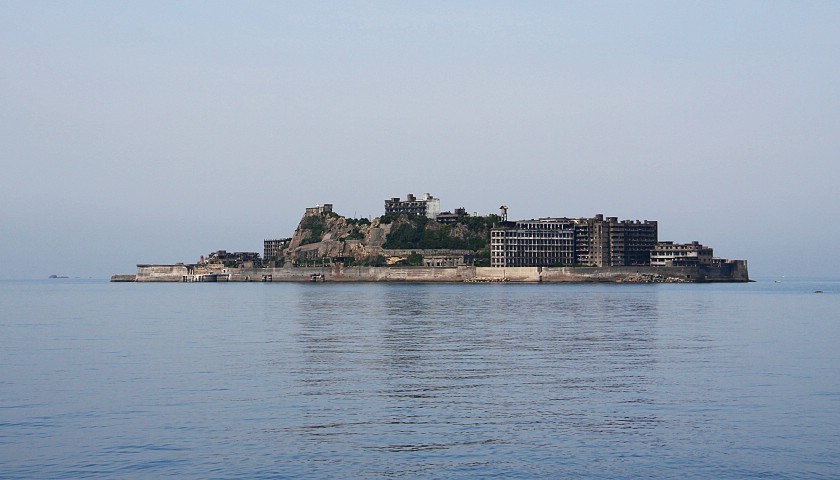
Gunkanjima (�R�͓�) is a small island located about 20 kilometers from Nagasaki Port. Until 1974, the island served as a coal mine, and more than 5000 residents called the 480 meter long, 150 meter wide island home, resulting in the highest population density in history recorded worldwide.
To accommodate so many people in such a small area, every piece of land was built up so that the island came to resemble a massive battleship. In fact, "Gunkanjima" is a nickname that means "battleship island" in Japanese . The island's formal name is Hashima.
Coal was first discovered on Gunkanjima in 1810 by the feudal lord of Saga. Industrial mining began in the late 1800s , and soon after, the island was purchased by the Mitsubishi Corporation. As production increased, the island was expanded, and large residential and industrial buildings and high sea walls were constructed.
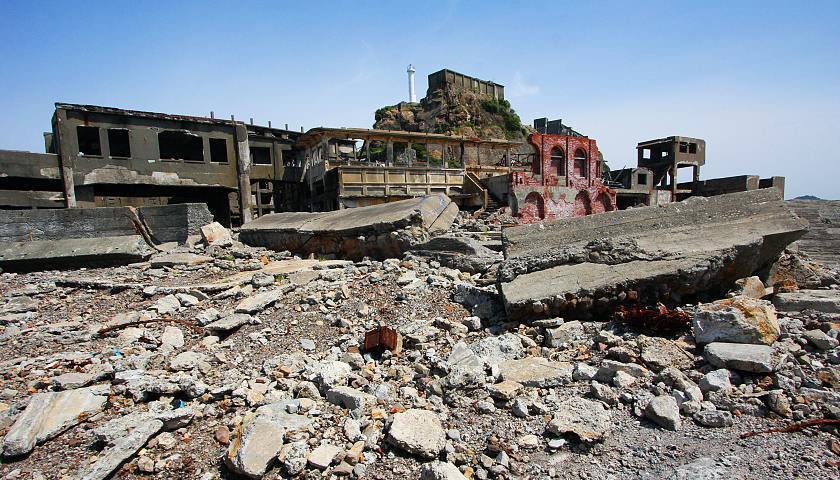
Managers, workers and their families all called the little island home. The residents were able to live out a more or less typical life. Half of the island was devoted to the workings of the mine, the other to residential space, schools, restaurants, shops, a public bath and a hospital.
In April 1974, the mine was closed, and its residents had to leave Gunkanjima, abandoning the island with all its buildings. Over the years since then, direct exposure to typhoons has caused the residences and mining facilities to deteriorate, giving the island an eerie and haunting atmosphere. Due to the danger of collapsing structures, Gunkanjima was closed to the public, and for many years could only be seen from sightseeing cruises that circled the island.
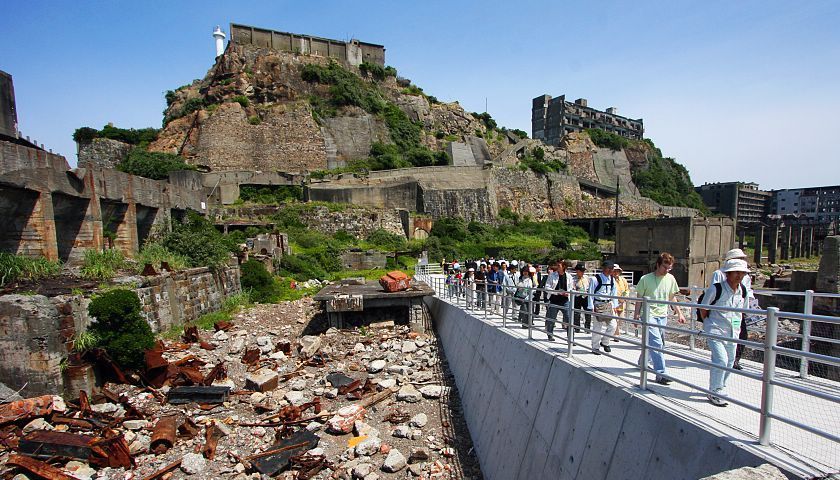
In 2009, a new boat dock made it possible for sightseeing tour boats to land on Gunkanjima. Tour participants are taken to three observation decks in a small part on the southern end of the island and spend about 45 minutes on the island with Japanese speaking tour guides. Tours do not involve getting too close to the buildings because of the risk of collapse.
The boat ride between Nagasaki and Gunkanjima is also enjoyable. Boats take about 50 minutes one way, and pass large Mitsubishi ship building factories and other islands along the way. The ride also allows for nice views of the city of Nagasaki and its port from the water.
For those unable to get to Gunkanjima, an alternative is the Gunkanjima Digital Museum near the Oura Church in Nagasaki . This modern museum boasts an impressive amount of information about the island, including a simulated journey down a working mineshaft and a digital installation that recounts aspects of living through testimonials and photographs. Visitors can also take augmented reality tours of certain areas of the island as they exist today.
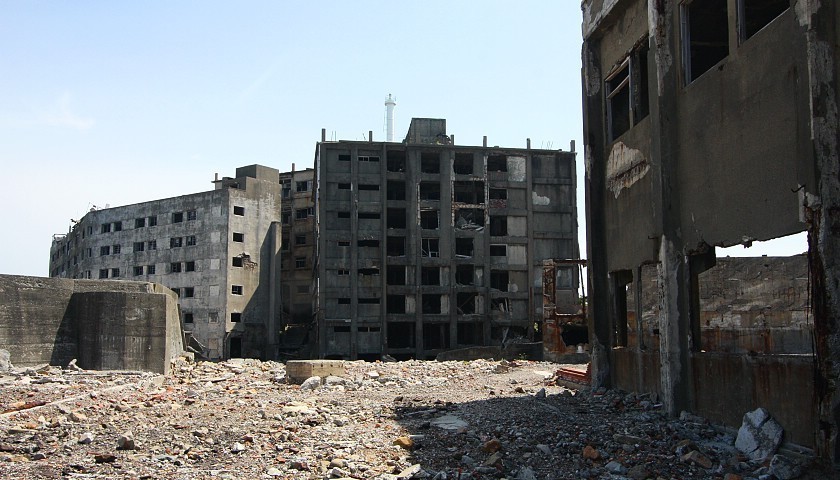

Getting there and around
Tour boats to Gunkanjima are operated by multiple companies and depart from various locations in Nagasaki Port, including the Nagasaki Port Ferry Terminal near the Ohato tram stop (3 minutes by tram line 1 from Nagasaki Station) and the Tokiwa Terminal near the Ourakaikandori tram stop (15 minutes by tram line 1 and 5 from Nagasaki Station).
The Gunkanjima Digital Museum is located a short walk from the Oura Church and the Ouratenshudo tram stop on tram line number 5.
How to get to and around Nagasaki
Hours and Fees
Multiple companies operate boat tours to Gunkanjima . Tours typically take about three hours, including close to an hour spent on the island itself, and cost around 3910-5810 yen per person. Note that in case of bad weather or high waves, landing on the island may not be possible or boats may not operate at all. Advance reservations are recommended especially on weekends and during holidays.
The Gunkanjima Digital Museum is open from 9:00 to 17:00 (entry until 16:30) with a small number of irregular closing days. Admission costs 1800 yen. The museum takes 45-90 minutes to explore and has a moderate level of English, which is contributed to by English headsets that follow the digital installation.
Questions? Ask in our forum .
Links and Resources
Yamasa kaiun, gunkanjima concierge, gunkanjima cruise, gunkanjima digital museum, hotels around nagasaki.
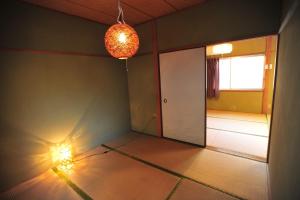
Gunkanjima Cruise (Hashima)
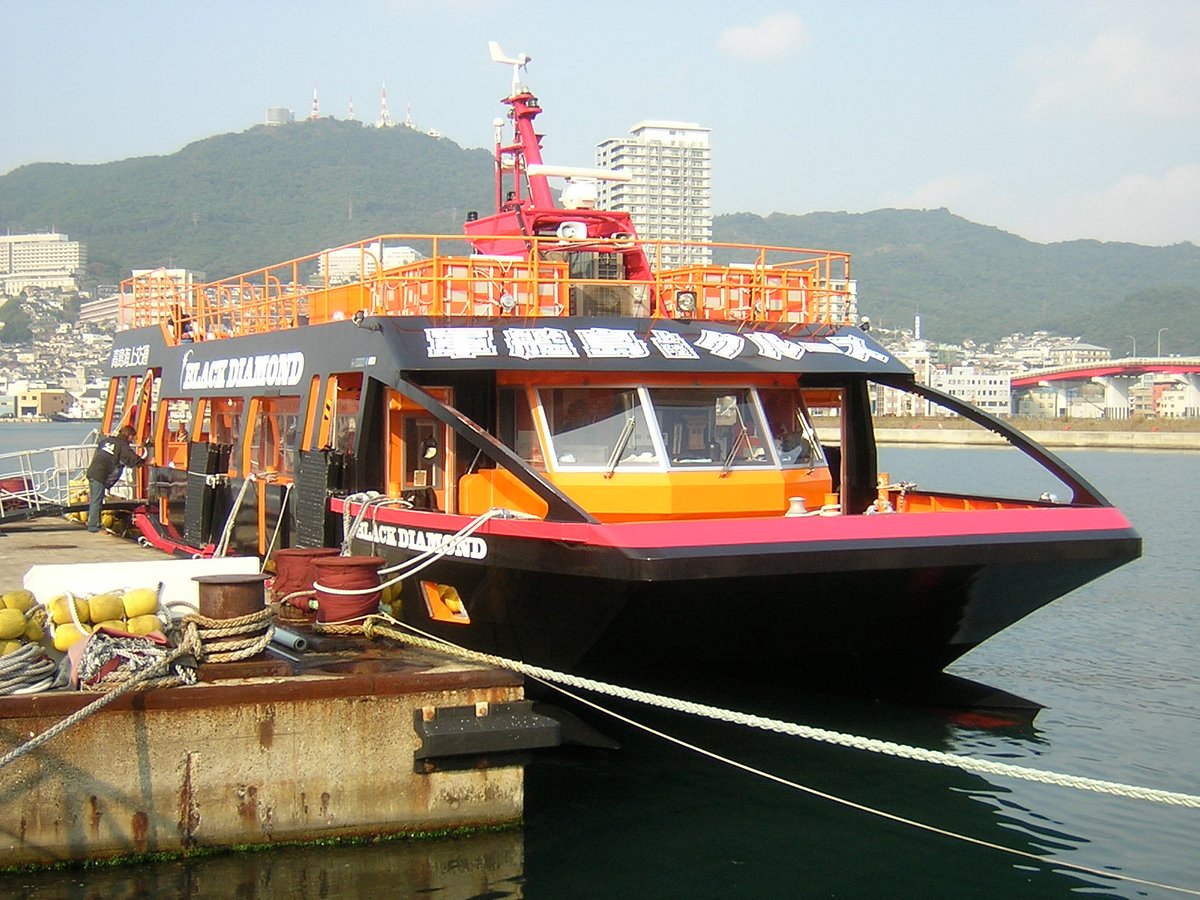
- See all photos
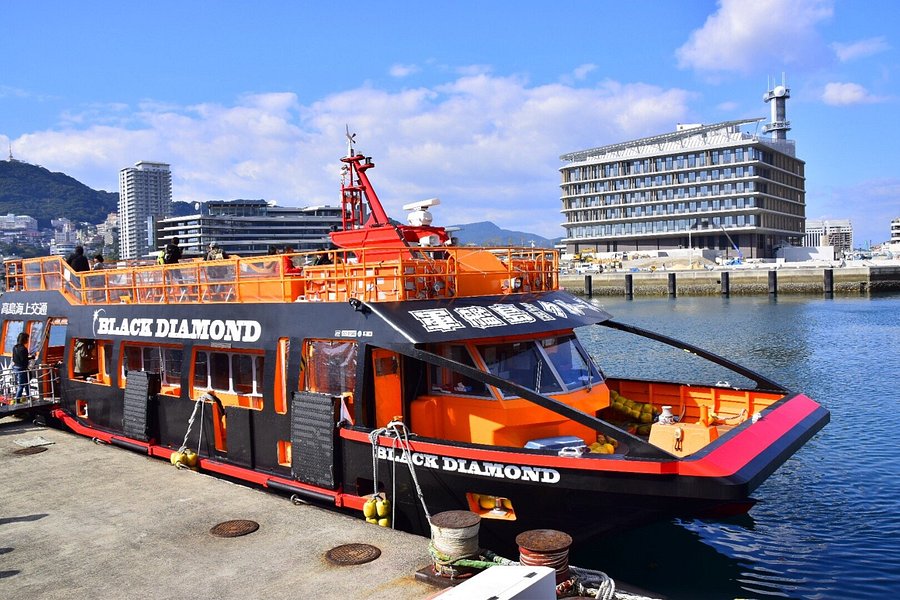
Similar Experiences

Most Recent: Reviews ordered by most recent publish date in descending order.
Detailed Reviews: Reviews ordered by recency and descriptiveness of user-identified themes such as waiting time, length of visit, general tips, and location information.
GUNKANJIMA CRUISE (HASHIMA) (Nagasaki) - All You Need to Know BEFORE You Go
Hashima Island ("Battleship Island")
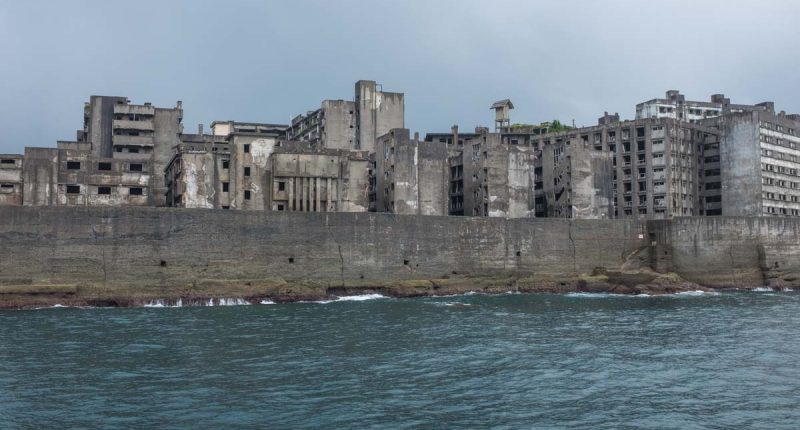
Tour of Sapporo Breweries Chiba Beer Factory
- Guided Tours
Share article
Hashima Island (端島) is an abandoned island and former coal mine located about 15 kilometers from Nagasaki . It is more commonly known as Gunkanjima (軍艦島) or “Battleship Island” because, from a distance, the outline of the island and the buildings bear an uncanny resemblance to a battleship.
The island remained deserted for decades after mining operations ceased in 1974, but in April 2009 Nagasaki City allowed tour boats to land on the island and today it is one of Nagasaki’s most popular tourist destinations. Popular culture has also helped give the island a second lease of life: Google released a Street View of the island which included many of the areas off limits to the public and it received another PR boost when it was used as inspiration for Javier Bardem’s lair in the Bond movie Skyfall (the film includes an aerial shot of the island, but filming took place in a studio reconstruction).
The History of Hashima Island
In 1853 Commodore Matthew Perry sailed his “black ships” into Edo Bay and provided the catalyst for a chain of events that would result in the Meiji Restoration in 1868 and the ending of Japan’s policy of sakoku (“closed country”). Japan had been living in isolation—aside from limited trading with the Dutch in Nagasaki —for the over 200 years.
Japan was suddenly made very aware of its technological and industrial inferiority to the Western powers, and, fearful of the consequences having seen China’s ports carved up and traded, it embarked on one of the most ambitious industrializations ever seen. And at the heart of that industrialization was coal.
Coal was first discovered on the Hashima Island in 1810, but it was only after Mitsubishi Goshi Kaisha (Mitsubishi Group) bought the island in 1890 for ¥100,000 (about $450k in today’s money) that mining operations began in earnest. Mitsubishi undertook major works that included building sea walls and aggressive land reclamation such that the island tripled in size over the course of the next 40 years.
The company also built the first concrete structure in 1916 to house the island’s growing number of workers—a 7-storey apartment block. It was this same year that an Osaka newspaper first reported that the island “looked like a battleship.” Over the next 55 years more buildings were added including a school, hospital, town hall, pachinko parlour, and cinema, and Gunkanjima became more than just a place of work—it was a close community of workers which, in many respects, resembled a large family. Community leaders would make regular rounds of the apartments to check everything was okay at home or help resolve neighbourly issues before they escalated. There were even cases where, upon reaching retirement, workers would choose to remain on the island rather than go back to the mainland (something that was permitted if their son also worked in the mines).
But there is a darker side to Gunkanjima. The conditions for all workers were so hellish that it is difficult today to try imagine what a normal day must have been like. Operating in 12-hour shifts, the miners—boys as young as 14 among them—would take railed trucks 1,000 meters below sea level to the mine. With temperatures around 40°C and sea-water seeping in through the rocks, these workers would lie prostrate and crawl through tunnels only 60 cm in diameter to pick away at the precious coal. Explosions from natural gas leaks were by no means uncommon. And among the workers there were tens of thousands of Koreans and Chinese who lived on the island as forced labour under the careful watch of Mitsubishi Goshi Kaisha (today’s Mitsubishi Group). In the six years from 1939 until 1945 1,162 Japanese, 122 Korean, and 15 Chinese workers are believed to have died, some from drowning when the shafts flooded with seawater.
Between 1891 and 1974 Hashima Island would contribute approximately 16 million tons of coal to Japan’s reserves. But as the oil replaced as the primary source of energy Hashima began to suffer. At its peak in 1960, 5,127 people lived on the island, representing a population density of 83,600 per square kilometer, probably making it the most densely populated urban area the world has ever seen. Even today, Kwun Tong, the most densely populated district of Hong Kong, has a population density of less than 60,000 per square kilometer. But by the mid-1960s that population had dwindled to just over 3,000, and when the mine finally closed on 15 January, 1974, fewer than 2,000 people lived on the island. By 1975 all had left.
In 2006, the Japanese government applied to UNESCO to register Hashima Island as a World Heritage Site. The move was immediately opposed by Korea, incensed that the application made no reference to the forced labour that was an undeniable part of the island’s history. The application was finally approved in 2015 as part of Japan’s Sites of Japan’s Meiji Industrial Revolution: Iron and Steel, Shipbuilding and Coal Mining.
Touring Battleship Island
Many boat and ferry travel companies offer guided tours of Gunkanjima. These tours disembark on the island so that visitors can see and photograph the abandoned and dilapidated buildings close up; however, due to the structural instability of the buildings (some have collapsed completely), visitors must follow a set course around the outskirts and are under no circumstances allowed inside any of the buildings. Below are some other points to note about the tours:
- Departure depends on weather conditions on the day
- Even if the tour boat departs for Hashima Island, the seas need to be relatively calm for the boat to dock safely. Consequently, it may be the case that you will be able to see the island but not complete the ground tour. In this case, tour companies may make a token 10% refund to visitors as compensation. Some visitors have been known to unfairly complain about tours not landing on the island, but passenger safety is the first priority for these companies. See below for the best times to take the tour.
- Guided tours are in Japanese (even if the websites are in English)
There are five tour companies with permission to land on Gunkanjima.
- Gunkanjima Cruise (English/Japanese)
- The Gunkanjima Concierge Company (English/Japanese)
- Gunkanjima Landing & Cruise (English/Japanese)
- Gunkanjima Tour (Japanese)
- Ebisu Cruise (Japanese)
Prices don’t differ all that much. For a “cruising and landing” tour the price is about ¥4,000 per person including the ¥300 landing fee levied by Nagasaki City. Guided tours take approximately 3 hours, including a 1 hour tour of the island itself. All tour companies offer a morning (9-10am) and afternoon (1-3pm) cruise.
As mentioned, visitors are not permitted inside the building for safety reasons, so here’s some footage to give you an idea of what you’re missing.
When is the best time to visit?
Some tour companies usefully provide detailed statistics about departure and landing rates. I imagine most passengers would rather reschedule the cruise than set off but not be able to land on the island. July to October tours that depart but cannot land are around 5-10% mark (closer to 20% on a bad year). During the winter months (November to February) it seems that if the boat departs it will almost definitely be able to land on the island, and during winter the clear skies mean you can get a great shot of the island from the boat.
Information
You may also like, yokohama chinatown, yamate district, hakone sekisho, ueno sakuragi atari.
- Haneda Airport
- Okachimachi
- Shimokitazawa
- Kiso Valley
- Nozawa Onsen
- Shinanomachi
- Kumano Kodo
- Japan Journeys Style
- Things to do
- Restaurants
- Hiking and Walking
- Amusement Parks
- Animal Attractions
- Museums and Digital Art
- Parks and Gardens
- Sports and Stadiums
- Temples and Shrines
- Experiences
- Places to stay

- Destinations
- Things To Do
Explore the Decaying ‘Battleship Island’ on a Gunkanjima Cruise
I have a morbid fascination with abandonments. They are symbols of death, bankruptcy, modernisation and economic downturn. Their grimy shadows hide secrets, their decaying decor illuminates history and their silence speaks volumes. Oftentimes, once the decision has been made to walk away, these buildings, amusement parks and towns are frozen in time, defenceless against the unyielding forces of nature, forgotten. But not always. In some cases, like Hashima off the coast of Nagasaki, efforts are made to preserve and even promote the sites as tourist attractions . Those with a penchant for urban exploration should take a Gunkanjima Cruise out of Nagasaki City to witness the crumbling former coal mining island for themselves.
Hashima, a decaying bubble
Hashima, often referred to as Gunkanjima, or Battleship Island, due to its boat-like profile, is a UNESCO World Heritage Site located 15km from Nagasaki ’s city center. Coal mining kicked off here around 1887 and continued for nearly a century until 1974. At its peak, Hashima’s population was over 5,000 people; for such a small island—160m east to west and 480m from north to south—this made it the most densely populated place on Earth.
Though mining was the main industry, residents also had access to schools, shops , a hospital, cinema and swimming pool among many other facilities. It was its own self-contained little world, with easy access to the mainland for anything else they needed. Since the collapse of the coal mining industry and the subsequent abandonment in the 1970s, Gunkanjima has been battered almost beyond recognition by typhoons, giving it a rather spooky appearance. The island was later opened to the public in 2009, but it’s not possible to explore on your own. Luckily, there are a number of tour providers that can ferry you to the island for a guided look.
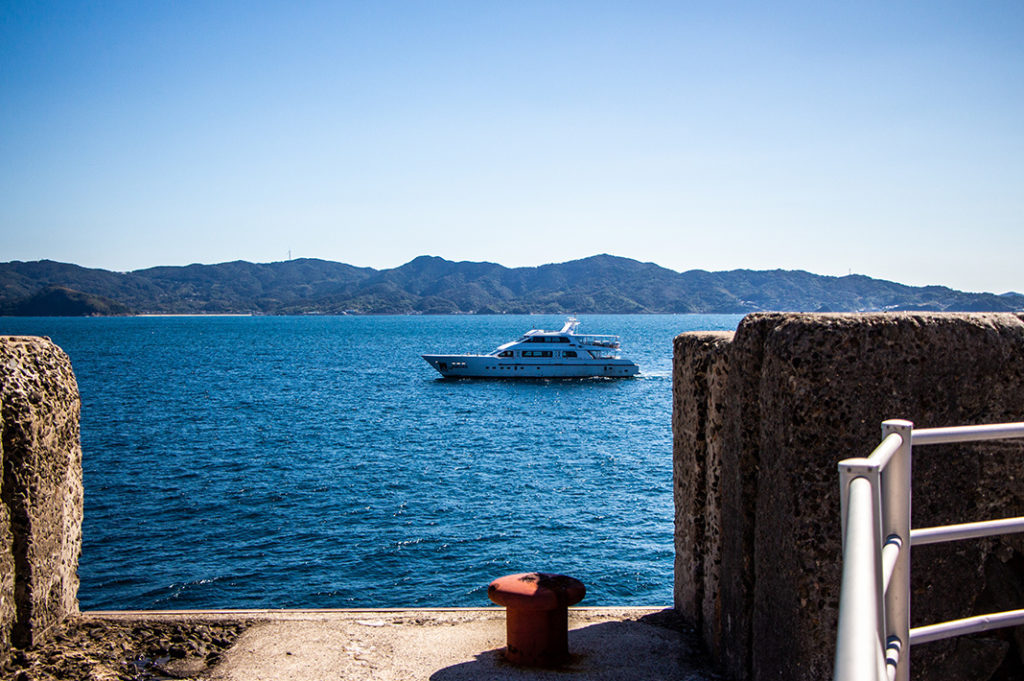
Gunkanjima cruise providers
There are only a handful of companies who are authorised to operate Gunkanjima cruises and tours. In the Motofunamachi area, not far from Nagasaki Station, you’ll find Gunkanjima Cruise Co. and Yamasa-Kaiun . Over at Tokiwa Terminal, near the Oura Church area, are the Seaman Gunkanjima Tour company and Gunkanjima Concierge —the latter of which I chose. Each of the providers offer morning and afternoon cruises, with tickets costing roughly 4,000 yen for adults across the board. Schedules and prices can be found on their respective websites where you can also book directly.
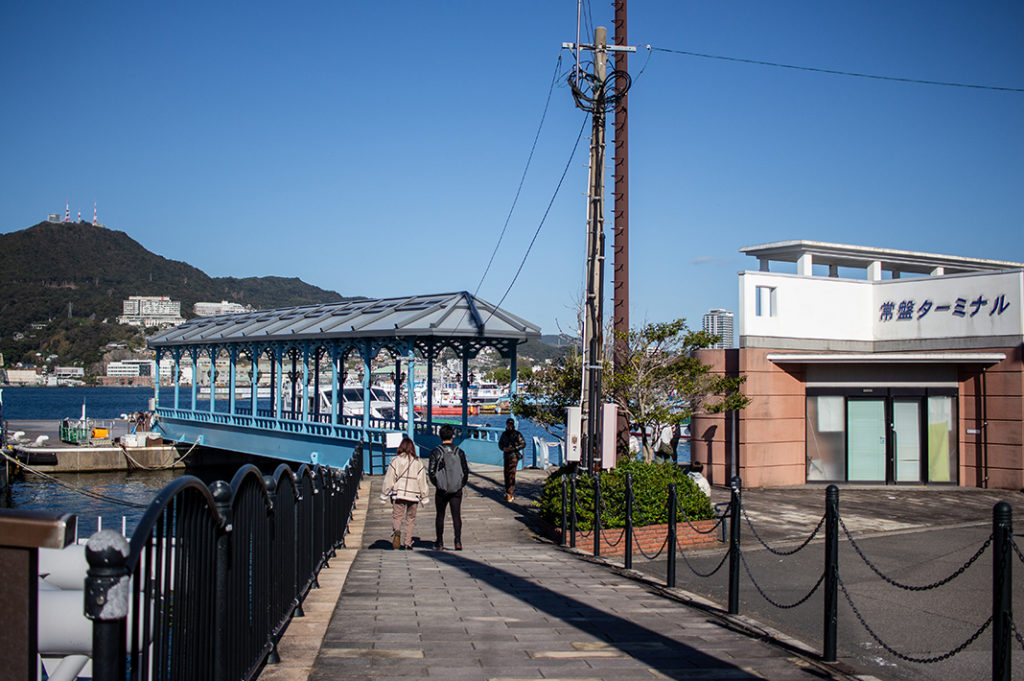
Gunkanjima Concierge
At Gunkanjima Concierge , the regular ticket costs 4,000 plus a 300 yen fee for accessing the island. I went with the next plan up, the ‘Priority’, which costs an extra 900 yen, and gave me half-priced entry to the Gunkanjima Digital Museum as well as priority boarding on the outbound trip. The museum contains three floors of digital displays, movies, images, models and even VR experiences to help visitors understand more about life on Hashima. It is also the check-in point for the cruise and is where you get your numbered sticker for boarding. I wanted to learn as much as possible about Hashima before visiting, so I went early to browse the exhibits with my discounted entry. I will cover this attraction in more detail in my next article. When it was time for the Gunkanjima cruise, I made my way a few blocks over to the Tokiwa Pier.
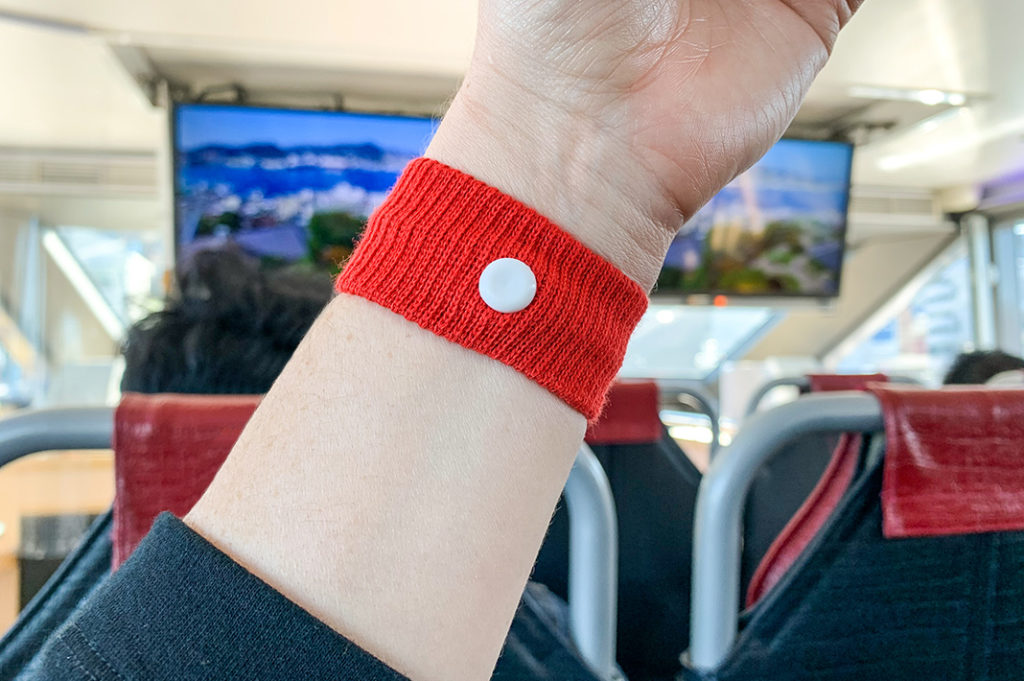
The cruise portion
I arrived to an excited crowd and a dismal forecast. On the day’s information board, the sea conditions were listed as simply a screaming emoji. Just as I had feared, rough seas were ahead. Perhaps seeing my ashen expression, a friendly staff member sidled up and suggested I head inside to purchase the anti-sea-sickness pressure bands; I’ve never spent ¥500 so quickly. By the time I’d gotten my bands in place and was given a folder full of information (in place of the usual English audio guide which was temporarily withheld due to social distancing measures), a long queue had formed beside the ship. This is when the priority boarding privileges came in handy, as I was ushered to the head of the line.
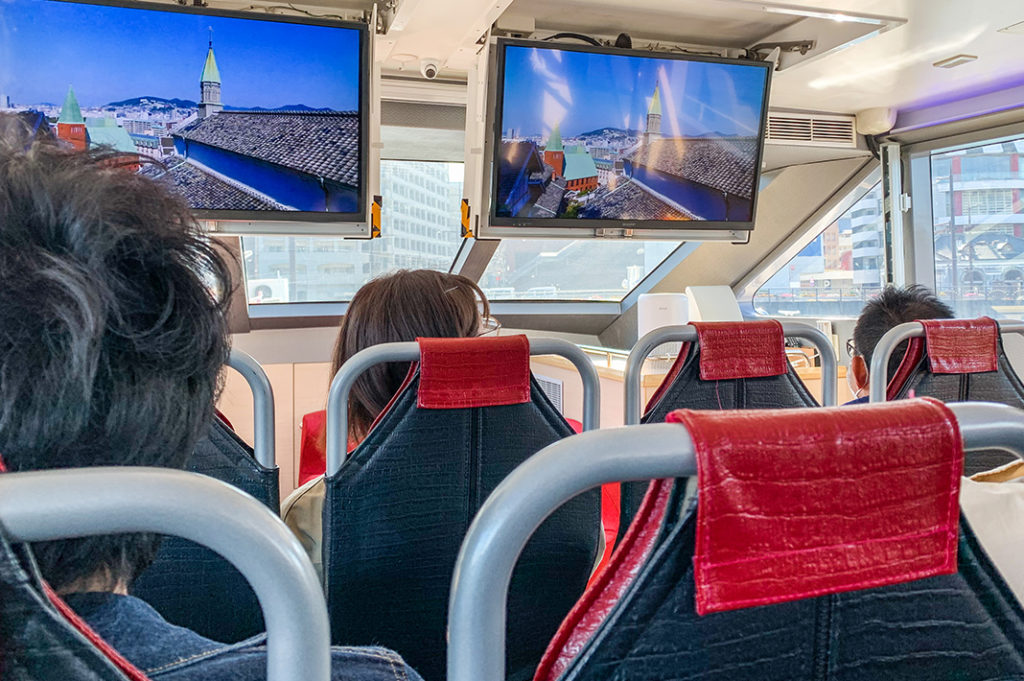
All aboard
The boat is a sit-where-you-like situation. However, the ‘Premium’ ticket (around 8,000 yen) holders had a special area upstairs, as well as VIP access to the front of the boat. I clocked the sick bags, took the boiled lollies from the staff and fastened my pressure bands as we commenced the choppy ride towards Hashima. The seats all faced the front where screens showed images and mid-century footage to accompany the guide’s presentation. He occasionally dipped into English for my sole benefit but the information folder was filled with interesting snippets.
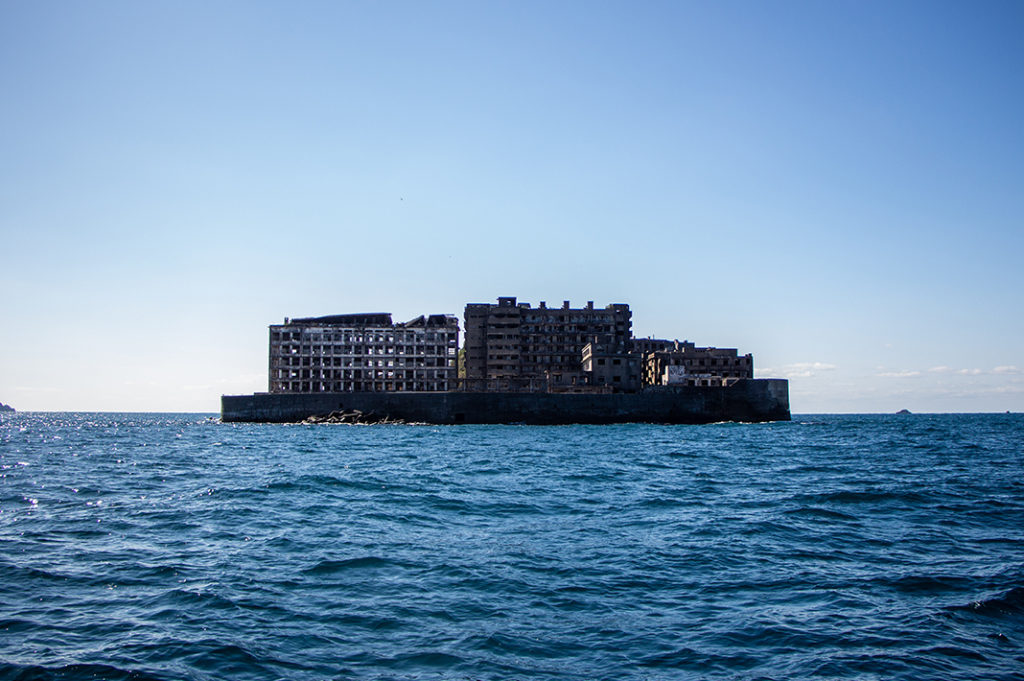
Once Gunkanjima was in sight, the Premium ticket holders went to the front of the ship for photos, while the rest of us went to the windows or out to the rear. The ‘three points of contact’ rule is king, here. It was rough . As we got closer, I could see the sky through the smashed out windows of the deserted high-rises, and the sea birds circling above.

Touring Hashima island
We disembarked and staff led us into the rubble. The roaring sea winds died down, silence descending over us. It’s far too dangerous to walk around the island unattended, so there are three designated viewing zones. Surrounded by concrete, rusted steel and smashed bricks, we made our way through as the guide spoke in Japanese about the history and function of certain buildings. Without the audio guide, I simply took in my eerie surroundings and photographed them.
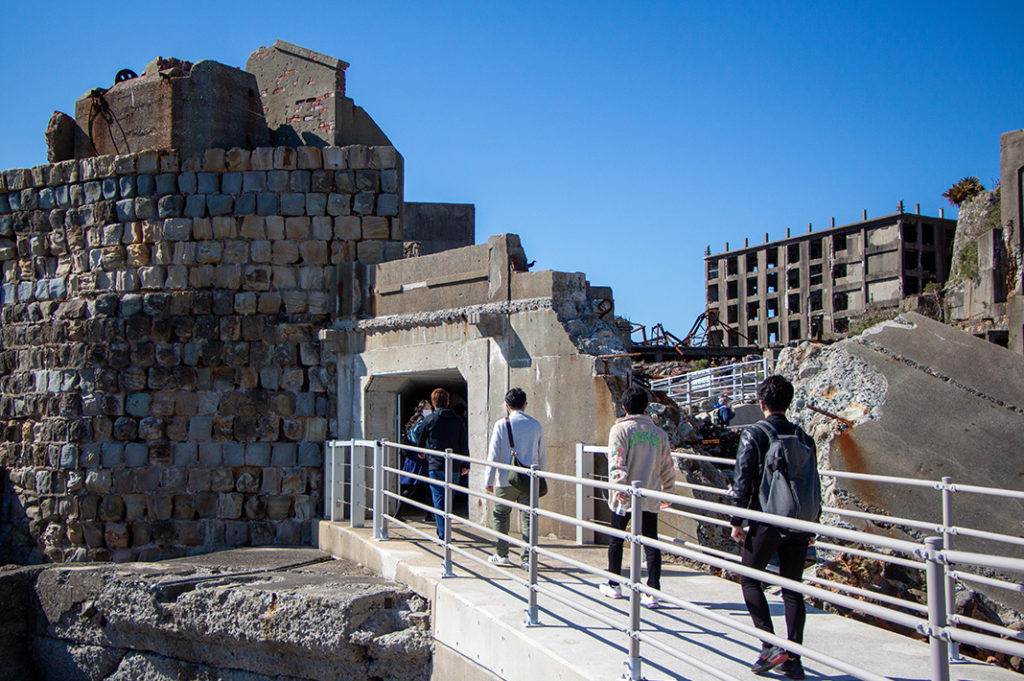
Hashima was home to so many people and many of the former residents have fond memories of their time here. The Digital Museum’s website has a written account from a former resident who returned to the island on a Gunkanjima cruise and said they wanted to scream. Those fond memories replaced by a dystopian warzone. Looking at the drab grey all around, I recalled what I’d read on the boat: that Gunkanjima was jokingly called ‘the island without green.’ At one time, rice paddies were set up on one of the rooftops to teach children about agriculture. Unfortunately, the building wasn’t waterproofed and the rice paddy leaked on the residents below. Oops!
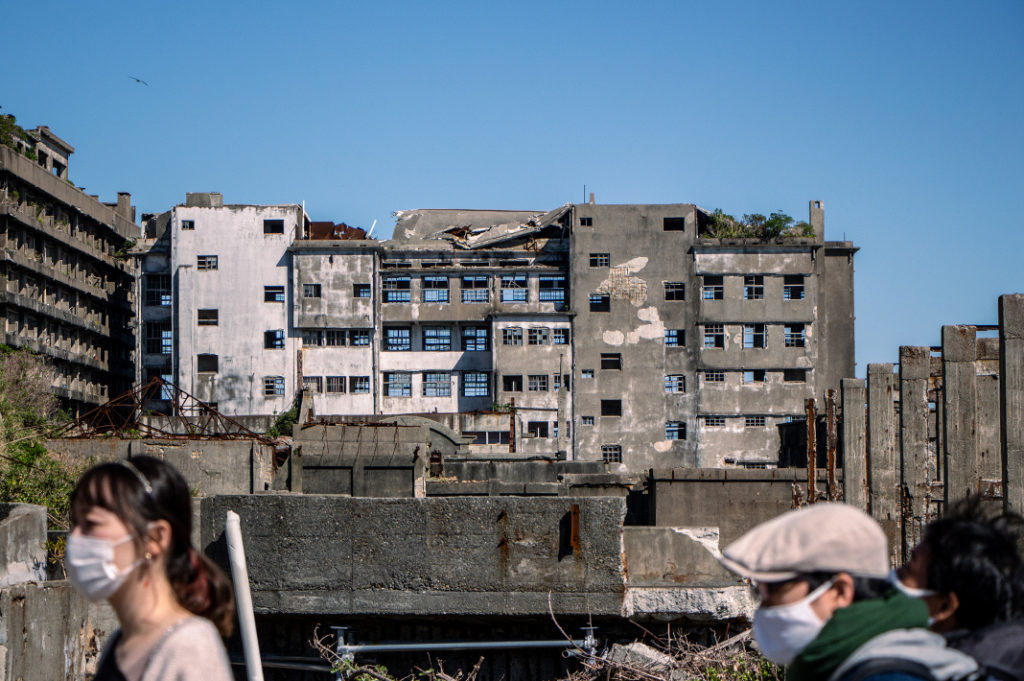
Of course, Hashima also has a sad history. It was, for a time, home to a number of POW labourers who were made to work in the mine. Perhaps this knowledge is what caused me to shiver when I saw the twisted remains of the mining equipment because it wasn’t that cold.
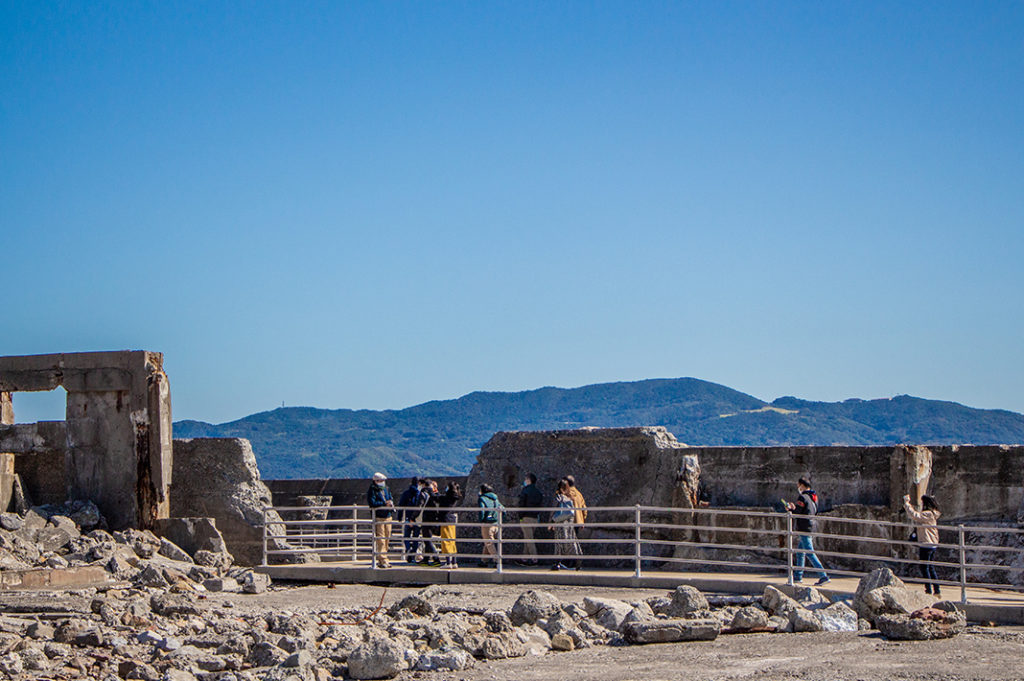
Heading back
The staff herded us back to the boat, as no doubt another tour company was coming our way. I checked to make sure my new favourite thing in the world, the pressure bands, were in place before climbing aboard. On the return journey, I read that Hashima is just one of over 500 abandoned islands in Nagasaki prefecture alone. In fact, Gunkanjima Concierge also offers tours of another island: Ikeshima. Unfortunately, it was closed due to typhoon damage but it’s earmarked for next time.
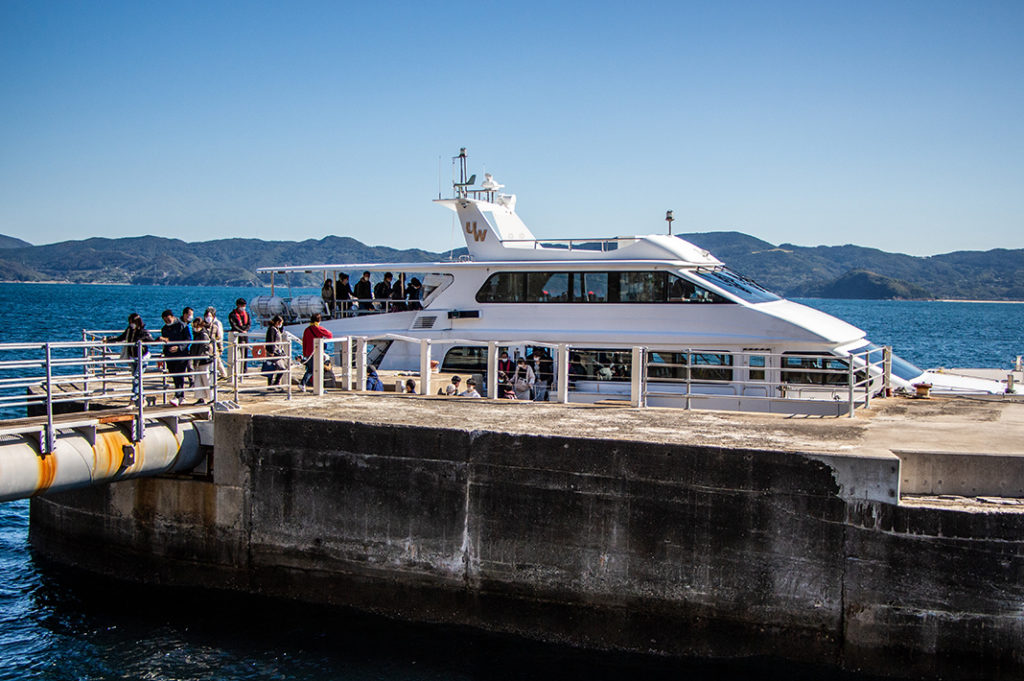
As we sailed back into Nagasaki Bay, our guide pointed out the Mitsubishi shipyard—previous owners of the Hashima mine and Gunkanjima island. It’s fair to say I’ll never look at one of their cars again without thinking of this day.
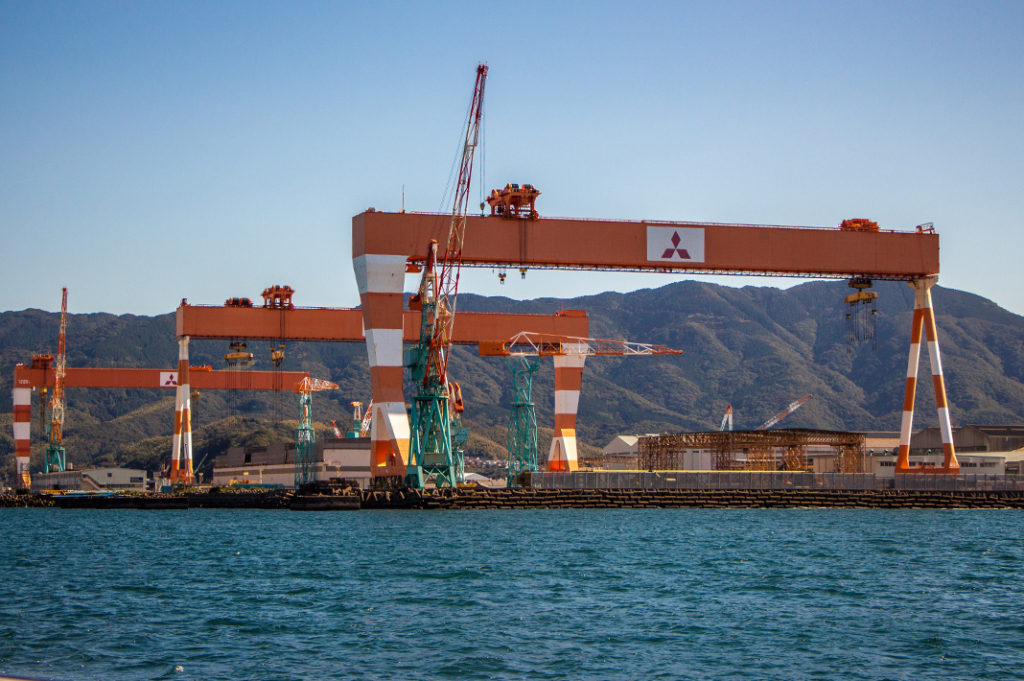
Visiting Hashima was a dream come true. As it is forever deteriorating, there’s no time like the present to visit. For those unable to visit due to poor weather conditions or a tight itinerary, you can always Google it. Amazingly, a person rigged with a 360º camera was sent in so we can experience the ruins using Google street-view. Alternatively, check out the 007 Skyfall movie which has a scene filmed on the island.
Post by Japan Journeys .
RELATED ARTICLES MORE FROM AUTHOR
Ine bay sightseeing boat: birds and boat houses, exploring tokyo’s biggest cave: nippara limestone caves, uga shrine: a power spot island on lake nojiri, most popular, a day at daio wasabi farm: the biggest in japan, island hopping in okinawa: where to go and how to do..., the char-grilled chicken wonderland: ukai toriyama, kurogi’s killer kinako kakigori – a shaved ice dessert to die..., ikana-akan osaka’s unmissable tenjin matsuri., art deco in tokyo’s ex-imperial forest: the teien art museum and..., it’s safe to visit this active volcano in kagoshima: sakurajima volcano, exploring cosplay shops in tokyo. destination: akihabara., nagasaki champon: the city’s most famous regional dish, our guide to how to catch the tram in nagasaki.
- Tokyo Cheapo (繁體中文)
Touring Abandoned Hashima Island (Gunkanjima or Battleship Island)
You’ve seen it in Skyfall and all over the media. Now a UNESCO World Heritage Site, Hashima Island — also known as Gunkanjima (“Battleship Island”) — has attracted attention for its post-apocalyptic, modern ruins. Here’s everything you need to know before visiting this Nagasaki prefecture destination.
Where is Gunkanjima?
What happened on hashima island.
- Things to know before visiting Battleship Island
Getting to Nagasaki
- Making sure you have the right island in mind
Note: As of September 25, 2019, boat tours are unable to land on the island due to damage caused by a typhoon. However, boats can still take you near the island. -->
Hashima Island (aka Gunkanjima) is located 12 miles (19 km) off the coast of Nagasaki . Nagasaki is located on the east coast of the island of Kyūshū, the southernmost of Japan’s four major islands.

As a world-class undersea mining operation, the island was once a symbol of Japan’s rapid industrialization. Mitsubishi bought the then uninhabited island in 1890, and soon it was transformed with modern buildings and conveniences. These included early examples of concrete apartment blocks and electric lighting. By the 1950s, the population had swelled to as many as 5,000 people, attracted by solid wages and a unique mining culture.
However, as coal power gave way to gasoline, coal prices fell, and many mines, including Hashima, were permanently closed. By 1975 the island was completely evacuated.
An abandoned Japanese island with a shady past
Hashima Island’s increase in popularity and status as a World Heritage Site, though, has not been without controversy. What many don’t know is that the island has a history of forced labor , both before and during World War II. The terrible conditions and unsafe environment led to untold suffering — along with as many as a thousand unrecorded deaths. Tour companies are often reluctant to talk about this, leading to suggestions that those in power are attempting to obscure the island’s history.
At the time of writing, Gunkanjima had no memorials to the victims of forced labor. Japan has pledged to set up a memorial and an information center in the years to come.
From local eyesore to world-famous attraction

Thanks to a total ban on visitors, Hashima Island was left to be reclaimed by what little nature remained — and remained practically untouched for decades. The eerie atmosphere of an industrial town where people seemingly disappeared mid-lunch eventually caught the public eye. Slowly but surely, brave individuals started returning to the island, exploring and taking photos.
However, the crumbling ruins — not to mention abandoned mines — meant that unregulated visits were an accident waiting to happen. Perhaps to combat this danger, official guided tours were eventually introduced.
Since the Japanese government lifted the ban in 2009, the island has become a popular destination for visitors to Nagasaki and Fukuoka . To cater to demand, several companies have begun offering guided tours, departing from Nagasaki Port. Prices range from about ¥ 3,900 to ¥ 5,100 per person.
Important things to know before visiting Battleship Island
If you want to visit Hashima Island (aka Gunkanjima aka Battleship Island), here are some things to know beforehand.
1. You can’t visit Hashima Island on your own

Safety first is the key principle here! Even though Hashima Island is one of Nagasaki’s top attractions, the buildings on the island really are at risk of crumbling. And since no one knows when they might crumble, the government has mandated that tourists can only visit as part of an official tour group. Unless you’re in journalism or media in general, sorry, that solo trip just isn’t happening.
Pro tip: [affiliate id="japanican" text="This tour to Battleship Island" link="https://www.japanican.com/en/tour/detail/ACT1J05004QQB/?typecd=TOU&kw=Battleship&typegrpcd=TPA"] is pretty good.-->
2. Nagasaki weather gets pretty rough
Gunkanjima is surrounded by treacherous waters. The sea is harsh, and even a slightly rainy, cloudy, and/or windy day is enough to set off the waves and impede visibility. Consequently, cruise companies reserve the right to cancel tours due to bad weather — even on the day of the tour itself or while you’re aboard the ferry.
In the case that the tour is canceled outright before it starts, you should be eligible for a refund. Sometimes tours depart Nagasaki only for conditions to worsen mid-journey. If it becomes no longer possible to dock at Hashima Island after you’ve departed, the tour will likely pivot to a cruise around the island instead — and you’ll be refunded the difference in cost.
In any case, just keep in mind that there’s always the risk of the tour not pushing through for reasons beyond human control. For reference, Yamasa Shipping’s website mentions that on average, the number of days in a year that tours successfully push through is around 100.
3. Gunkanjima is not for the faint of heart

See the above point on Gunkanjima’s waters. More than the cost, the major obstacles to visiting Hashima Island are inclement weather and health. If you’re prone to seasickness and motion sickness, this probably isn’t the tour for you. On a particularly rough day, even those who don’t easily suffer from those conditions may also feel unwell. I don’t get motion sickness easily, but there were several times when I felt like throwing up, and I finally did during the ride back.
Having anticipated that guests might feel uncomfortable on the journey, the staff distributed towels, candy, vomit bags, and even a wristband that’s supposed to help combat motion sickness, but those still weren’t enough for me. (They don’t sell anti-motion sickness medicine, though, so bring your own just in case.)
If these don’t discourage you, then good for you! But just remember that your health is more important than any tour, however awesome it may be. In my case, it was a short but memorable experience, but would I do it again? I don’t think so, because of the bumpy ride!
Editor’s note: Motion sickness medicine in Japan is called yoidome (酔い止め) and it can be purchased at any major drug store chain.
4. You may be refused admittance based on your physical condition

This isn’t because of discrimination; again, it’s for safety reasons. The tour companies we list don’t reject reservations from pregnant women, as well as people with disabilities and chronic illnesses. However, harsh weather conditions and other unforeseen circumstances could still lead to pregnant women suddenly being barred from joining a tour.
Unfortunately the ferries are not wheelchair accessible , and Gunkanjima isn’t a wheelchair-friendly location, either. Those with serious chronic illnesses are also discouraged from joining. It’s best to inform the tour companies beforehand about any physical conditions you have, just so you have an idea of whether you can go ahead with that reservation.
5. Babies and pets are not allowed
We’re not sure why anyone would think of bringing a baby or a pet on a tour like this, but if you’re thinking about it, don’t. No tour operators allow kids under 3, and they really prefer kids to be in elementary school and up. Some will let you book for preschoolers, but others won’t.
Part of this is because of Nagasaki law, which says children under 6 can’t be on the deck of the boat. So if you’re traveling with a child aged 3–6, you’ll have to remain seated with them inside the boat at all times — rather than crowding on the deck with everyone else trying to get photos. And there is still a chance the captain can decide it is too unsafe for a preschooler to disembark.
6. You have to sign a safety contract

You have to agree to follow their rules, which are basically common sense anyway: don’t join the tour intoxicated; don’t go off on your own upon disembarkation (yes, following the guide is really important; they need a license to conduct those tours so they know better) — things like that.
Pro-tip: Read more about haikyo (Japanese for “ruins” but usually referring to modern ones) as an exploration of Japan, past and present
7. There’s an additional ¥ 310 fee on top of the tour cost
It’s a fee set by the local government and it goes to the preservation of Gunkanjima. You pay this to the tour company, with some including it in the price and some charging seperately. For children the fee is ¥ 150 .
8. The Hashima Island tour is 60 minutes long — max

Again, this is a government-mandated thing, and it’s for everyone’s safety. You’ll follow a guide down a prescribed route and stop for photo ops here and there. You won’t really see much of the island, but you’ll at least get a glimpse of the urban decay. And no, you can’t get close to, let alone explore, the ruins. Safety first, remember?
Yes, the round trip to the island takes longer (as just going one-way can take up to an hour, depending on conditions), and while this may be a letdown for some, keep in mind that there’s no other way you can see Gunkanjima. It’s not like it’s some tourist spot in Tokyo , Kyoto , or Osaka that’s easy to get to. And, hey, it’s better than nothing!
9. Skyfall wasn’t actually filmed there
The island was famously featured in Skyfall as the lair of Raoul Silva (a former MI6 agent gone rogue). In reality, the abandoned island just inspired the eventual design of the film, which was actually shot in Macau. So while the reputation for villainy stands out for tourists, only external shots were ever shown in the film. The island was, however, used as a filming location for the less-acclaimed Attack on Titan film, back in 2015.
Tours to Hashima Island

Depending on the company, you might see tours listed for “Battleship Island”, “Abandoned Japanese Island, “Skyfall Island,” or “Ghost Island.” But when it comes to what you see on Hashima Island, all tours are the same. Only a small section of the island is open to visitors, and you’ll be joining a guided tour (with probably 15–30 other people) along a prescribed route.
The time you get on the island is also the same across tours: about 45 minutes — or an hour at max (depending on the ferry crossing conditions). All tours require advanced reservations, which can be done online.
Gunkanjima tour guidelines
- Dress appropriately: Be sure to wear trainers/sneakers (and definitely not heels! but also: no sandals) and some kind of sun protection, as there is little shade on the island; also be warned that it can be very windy, especially in winter.
- Rain doesn’t necessarily mean tours won’t run. Note that umbrellas (and parasols) are not allowed on Hashima Island, so bring a rain jacket if the sky looks questionable. Operators will probably also have plastic ponchos for sale/rent/or maybe for free.
- There are no toilets on the island, and only one or two likely on the boat, so plan accordingly!
- You can take photos and videos on the island and during the journey over (though some operators may ask that you don’t film the guides), but absolutely no drones.
Hashima Island tour companies
All of these are operators licensed, so don’t worry — you’re in good hands.
Note that all of the tours below leave from different locations, but all can be easily reached from Nagasaki Station, either by tram or on foot. Be sure to arrive 30–45 minutes before departure time (following the instructions for the operator) to complete the check-in process.
Yamasa Shipping Co. Ltd.
9 a.m. and 1 p.m daily ¥ 4,200 per adult
Yamasa Shipping Co. Ltd. tours are the priciest on our list but they do come with a considerable perk: guides who speak English or Chinese.
English guides are available on Tuesdays, Thursdays, and Saturdays, while Chinese guides are available on Mondays, Wednesdays, Fridays, and Sundays (let’s hope you don’t have a mixed group of friends!).
If you book online in advance, you can often score a 5–10% discount. Tickets are also a few hundred yen cheaper for junior high and high school students; meanwhile children 6–12 can join for half the adult fare.
Tours last around 2.5 hours, about two-thirds of which is spent on the boat — but that’s pretty standard. Remember, there’s lots to see from the ferry as well!
Additional details
Booking link 095-822-5002 Nagasaki Port (meet at window no. 7, Nagasaki Port Terminal Bldg.) Tram line 1 to Ohato or a 15-minute walk from Nagasaki Station

Gunkanjima Concierge
9 a.m. and noon (or abouts) daily ¥ 5,000 to ¥ 5,500 per adult (includes entry to Gunkanjima Digital Museum)
Gunkanjima Concierge tours include admission to the Gunkanjima Digital Museum , which is value of ¥ 1,800 (for an adult ticket). So if you’re keen to do both then this tour is the best value for money. The museum is pretty cool and includes VR experiences, projection mapping, and interviews with people from the island along with items, photos, and a short film.
Tours depart from the museum. If you opt for the morning tour, meet up time at the museum is between 9 and 10 a.m. — which means you can visit the museum then, or afterwards. For the afternoon tour, check-in time is between 10:30 a.m. and 1 p.m., which gives you plenty of time at the museum.
The tours have audio guides for foreigners as the tours are conducted in Japanese. They boast an impressive 94% landing rate and a 91% departure rate.
Gunkanjima Concierge ticket classes
This cruise is a little different from the others in that there are different ticket classes. Ticket class determines your ferry experience — not the island tour, which is the same for everyone.
- Super Premium: Reserved window seat above deck; priority boarding and disembarking; access to a second floor deck for photo-ops
- Premium: Reserved center seat above deck; priority boarding and disembarking; access to a second floor deck for photo-ops
- Standard: Unreserved seat below deck
Gunkanjima Concierge ticket prices
Peak days are defined by the operator as national holidays, Golden Week, summer vacation, and winter vacation. But since you’re booking ahead there shouldn’t be any suprirses.
There are concessions for junior and highschoolers ( ¥ 1,000 discount) and also elementary school kids ( ¥ 3,000 discount for super premium and premium class or ¥ 2,500 discount for standard class).
Preschoolers ( ¥ 1,500 / ¥ 2,000 weekdays/weekends) can only ride standard class, as they must stay below deck for the duration of the trip.
Booking options: Direct via the operator or via Klook 095-895-9300 Tokiwa Port (meet at the Gunkanjima Digital Museum) Tram line 5 to O-Urakaigandori (30 min from Nagasaki Station + 1 transfer)
Note: Klook does not seem to have the same refund policy as the operator should cruises be canceled.

Gunkanjima Cruise
9:10 a.m. and 2 p.m. daily ¥ 3,600 per adult
Gunkanjima Cruise is the cheapest option, costing just ¥ 3,600 for adults (and ¥ 1,800 for children 12 and under). No tiered pricing or add ons — just a simple flat price.
Tours last a little over 3 hours, and actually visit two islands: Takashima and Hashima. First you’ll sail 40 minutes (ish) to Takashima, where you’ll have 30 minutes to visit the island’s Coal Museum. The highlight here is a scale model of Gunkanjima; there are also some artefacts that shed some light on the life of the miners.
Then it’s a 15-minute ride to Hashima Island, where you’ll have 45 minutes or so of guided viewing of the island.
There is one major downside: no English-language tour guidance. So you’ll be following a tour led in Japanese (you can’t just go off on your own, even if you don’t understand).
Cruises depart from Motofuna Pier, which is a short walk from the Ohato tram stop. Be sure to arrive at least 20 minutes before departure for pre-departure procedures such as registration and payment.
Booking link 095-827-2470 Motofune Pier (11-22 Motofunamachi, Nagasaki City) Tram line 1 to Ohato or a 15-minute walk from Nagasaki Station

Visiting Gunkanjima requires first getting to Nagasaki , which is in Kyūshū. There are international flights to Nagasaki Airport from Shanghai and Hong Kong. Otherwise your only option is to come from elsewhere in Japan. Fortunately, Nagasaki is a major city served by frequent domestic flights, trains, and buses.
Flying to Nagasaki
There are domestic flights to Nagasaki Airport from Tokyo (both Narita and Haneda), Kansai International, Osaka Itami, Kobe, Nagoya Chubu, and Naha.
Both Japan Airlines and All Nippon Airways have discounted fares for foreigners who can show proof of residence outside Japan and a ticket back home. If you’re eligible, the fare is ¥ 11,000 for one-way for flights to Nagasaki.
If you want cheaper than that, look into Japan’s low-cost carriers . For example, Peach Air flies to Nagasaki from Osaka’s Kansai International Airport for as little as ¥ 4,000 one-way. The journey is just over an hour.
Alternatively, you can fly to Fukuoka from Kansai (about 1 hour, also for around ¥ 4,000 one-way for Peach) or Tokyo (about 2 hours, starting at around ¥ 5,000 one-way), then take a 2-hour bus (for about ¥ 2,500 ) to Nagasaki.
Unfortunately, getting from Nagasaki Airport to Nagasaki isn’t super convenient, requiring an hour-long bus journey or a pricey taxi ride.
The New Nishikyushu Shinkansen
Trains are an option, especially now that Nagasaki has a Shinkansen station. If you’re traveling with a JR Pass , getting to Nagasaki from anywhere in Japan won’t cost you any extra.
Since September 2022, the the brand new West Kyūshū Shinkansen began service between Takeo Onsen and Nagasaki. Unfortunately, the line isn’t linked up the rest of the Shinkansen network (because of some drama), so you have to take a Ltd. Express train between Takeo Onsen and Fukuoka. It’s annoying extra transfer, though the new Shinkansen does make the trip 30 minutes quicker.
There are also overnight buses from various areas in Kansai.
Make sure you have the right island
We’ve seen quite a few mis-spellings online for Hashima. The most common is “Nashima”. Presumably people are getting it confused with the famous art island of Naoshima , which believe us could not be more different.
While we do our best to ensure it’s correct, information is subject to change. This post was first published in March, 2015. Last updated in April 2023.
- Hashima Island
- Japanese history
Get the best Japan Cheapo hacks direct to your inbox

Updated: 2024 Japan Cherry Blossom Forecast
The blooms are fashionably late. Here's when to see sakura in all the major cities.

April 2024: Top Events Around Japan
Look forward to flowers and festivals galore!

8 Perfect Places To See Cherry Blossoms in Osaka
Castle grounds, sprawling parks — and somewhere extra special.

Cherry Blossoms in Kyoto: 14 Best Sakura Spots
From temples to riversides, geisha districts — and more.

9 Things To Do in Fukui
Explore the shiny new stop on the Hokuriku Shinkansen — an easy trip from Tokyo.

6 Must-See Fertility and "Penis Festivals" in Japan
Stop giggling and start reading.

11 Best Places to See Cherry Blossoms in Japan
Riverside paths, real castle moats, pagodas and more.

Ghibli Park Guide: Tickets, Getting There and More (Updated)
Now with the Valley of Witches, and real-life cat buses.

Osaka to Tokyo: The Fastest and Cheapest Ways to Get There
Handy information on your travel options between the two cities.

March 2024: Top Events Around Japan
Plum and cherry blossoms, spring festivals, the Grand Sumo Tournament in Osaka — and more!

The Survival Guide to Kyoto Station
Bookmark this for easier travels.

5 Reasons To Visit Ishikawa
The prefecture extends a warm welcome, as part of its efforts to rebuild in the wake of the Noto earthquake.

Recommended hotels located nearby

Close without accepting
JAPANESE ISLANDS
OTHER CONTENTS
Scenic Japan from the Water
Route details, "gunkan-jima" around and landing cruise (nagasaki~"gunkan-jima" line).

the cruise ship of around and landing GUNKAJIMA.
Yamasa shipping Co,.Ltd

"Gunkanjima" is a popular name of Hashima, an isolated island floating on the sea about 19 km southwest from Nagasaki Port.
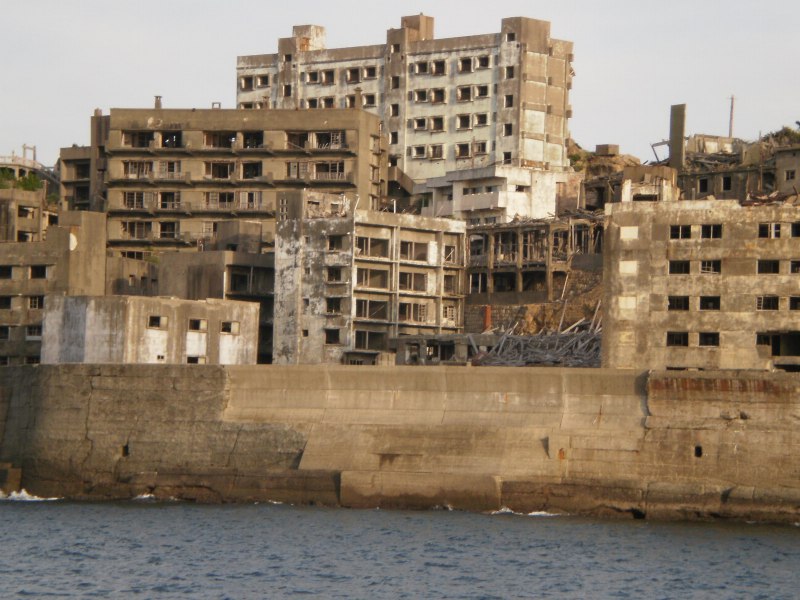
Gunkan-jima
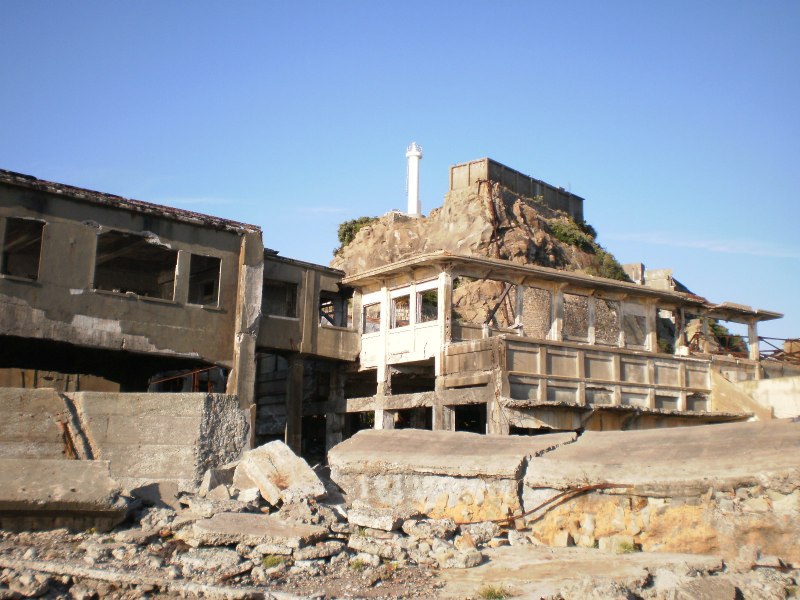
Gunkanjima"Hashima"
Japan's Battleship Island
©Nagasaki Prefecture Convention and Tourism Association

Saikai Brige

Mt. Nabekanmuri
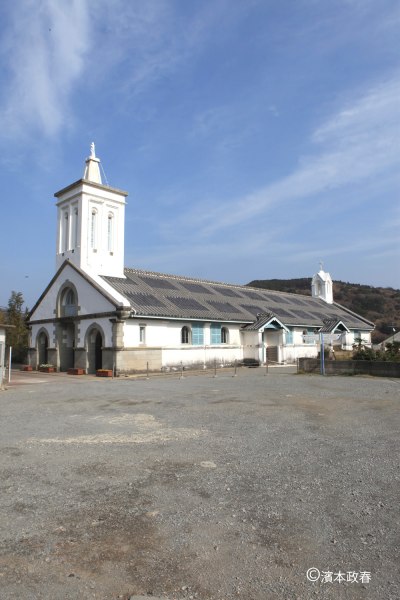
Shitsu Catholic Church
Taking and uploading photographs have been approved by the archdiocese.

Ports of Call
- Nagasaki Port Terminal Building
Click the port of call and it will appear on the map
Tourist Attractions Nearby
- Kyoto & Nara
- Kanazawa & Takayama
- 7 Days or less
- 14 Days or More
- 7 Days or Less
- Independent 3 Day Packages
- Independent 5 Day Packages
- Independent Ducati Packages
- Barrier Free
- Book Japan Rail Pass
- JR East Pass
- JR West Pass
- JR Hokkaido Pass
- JR Central Pass
- JR Kyushu Pass
- JR Shikoku Pass
- Journey Planning
- Seat Reservation Information
- Baggage Information
- Rail Pass FAQ
- Okinawa Unique Stays
- Okinawa Ocean Adventures
- Okinawa Jungle Adventures
- Okinawa Tradition & Culture
- Okinawan Cuisine
- The Ryukyu Kingdom: A Brief History
- Island Life: Okinawan Culture and Traditions
- The Nature of Okinawa
- Local Specialities: Diet and Longevity in Okinawa
- Okinawa Hontō (Okinawa Main Island)
- Okinawa Shoto (Kerama Islands)
- Miyako Retto (Miyako Island)
- Yaeyama Retto (Yaeyama Islands)
- Driving in Okinawa
- Fukushima Activities & Family Fun
- Diamond Route Japan
- Fukushima Food
- Fukushima Onsen Experiences
- Fukushima Unique Stays
- Driving in Fukushima
- Spectacular Snow
- Visa Assistance
- Our Branches
- Agent Login

- Battleship Island Gunkanjima Cruise & Landing
Gunkanjima Cruise & Landing
From $69 aud.
https://www.traveljapan.com.au/booking-conditions
Take a cruise from Nagasaki Port to UNESCO World Heritage Site Gunkanjima (Battleship Island) that has been getting worldwide attention as it was the model for the “Dead City” in the James Bond movie “Skyfall” See beautiful views of Nagasaki on board, and upon landing, explore this abandoned relic from the Meiji Era.
Day 1 Nagasaki
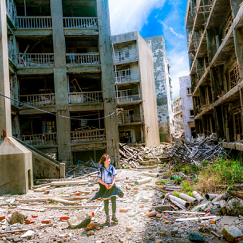
12:50 pm: Make your way to the Boarding gate in Tokiwa Terminal.
13:40 pm: Depart from Nagasaki Port. Cruise around Gunkanjima and landing: From the cruising route, you can view buildings that cannot be seen on the land tour. After landing, provide guidance by professional guide staff throughout island.
16:05 pm: Arrive at Nagasaki Port. Please make your own way to your next destination.
- Cruise and landing fee
- Landing time is "30-40 minutes" according to the regulations of Nagasaki City. And our captain will make the final decision of the landing time by the wave condition then.
- On the island, we will make a round trip about 220 meters, and the guide will explain about the photos of those days at the square of three view points.
- Due to the safety rule, it is not allowed to use umbrellas in the island. Please prepare rain wear on rainy days. You are also able to buy a simple rain wear in the ship (JPY 200 per rain wear).
- On nice weather days, the light might be dazzling, so that we strongly recommend passengers to bring with hats and drinks. (Due to the safety rule, it is not allowed to use umbrellas in the island.)
- Please put on sport shoes or shoes with a flat heel. Due to the fact that the landing pier of the Gunkanjima is an iron-barred bridge. Walking with high heels is not recommended.
- Crossing the gangway while getting on/off the ship might sometimes be dangerous. Passengers shall wear clothes light and convenient.
- Rain and water may splash on the deck place. (outside seats on first and second floor) Our captain has right to ask passengers move to inside seats if the wave condition or weather is bad.
- When taking the ship: It might be very wavy while the sea condition is bad, please follow the directions by our staffs.
- Not allowed to go inside or next to the buildings, because w e do not know when they will collapse. But you will be able to observe the high-rise apartment buildings from the ship, when having a tour around the island.
- Inside the island, you will be required to follow the guide and other staffs instructions, and move into a single group.
- Due to the narrowness of the path, we will ask visitors to not take pictures standing in the middle of the path.
- Pictures shown are illustrations purpose only.
Ready to explore?
« Back to Product Listings
More Japan Travel Packages
Beppu half day sightseeing, huis ten bosh 1-day bus tour, arita ware private tour and lesson with a master potter, evening walking tour with local onsen and izakaya dinner experience.

What is Gunkanjima or Battleship Island?
The name and history.

“Gunkanjima” is the nickname of “Hashima”, a solitary island floating in the sea about 19 KM or 12 miles southwest from the Port of Nagasaki.
Gunkanjima is also an island with seabed coalmine, which had underpinned modernization of Japan by supplying usable coal for iron-making. This coal was mainly for the Yawata Steel Works, which have been managed by the Mitsubishi Mining Company since 1890.
Although, in the beginning, the island was just mere nude aqueous-rock-shallows, the present figure has been formed with repeated expansions of the sea wall by reclaiming the surroundings in step with advances in the mining technologies.
House construction for employees had been increased along with the developments with the coal mine. A string of multi-story apartments with reinforced concrete had been constructed since 1916.
Gunkanjima was forested with the multi-story apartments that had a population of more than 5,000 people, producing the appearance of a fortress of the sea, which looked like “Tosa” a battleship (or gunkan in Japanese). This is how it came to be known as “Gunkanjima,” meaning battleship-island.
Energy-reform-stricken rationalization had been promoted in the coal mine since the first half of 1960’s. The coal mine shut down on January 15, 1974. Gunkanjima became an inhabitant island on April 20 in the same year.
Information about Cruising Fare and Time Table
- Gunkanjima Landing & Cruise

The island became open to the public for visiting on April 22, 2009. You will be enchanted by the breathtaking views of “Gunkanjima”, known as the man-made-island for the seabed coalmine, after landing. You will also receive satisfaction from the sights on the ferry while sailing around the island. Both views of short-distance and long distance will be engraved in your mind’s eye forever.
Authorization conditions require a signature on the Agreement. Click here to download the documents to be submitted for the “Gunkanjima Landing & Cruise.”
- We arrange Chinese and English guides for our passengers from abroad. The guide fee is free. Chinese guides are available on Mondays, Wednesdays, Fridays, and Sundays, and English guides are available on Tuesdays, Thursdays, and Saturdays. - A group discount fare shown below is applied to groups of 15 or more. - The fares for the Gunkanjima Landing & Cruise includes “a round-trip fare”, “a guiding fee on the island”, “a safety guide fee” and “a cruising guide fee.” - We will make a full refund of landing fees and 10-percent passage fees in case if you can’t effect a landing. - We may not be able to set sail depending on weather conditions. Reservations are required. - A signature on the “Agreement” is a requirement. - Please check the details of the “Agreement” and “Things to Note When Visiting Gunkanjima.” - We began to accept junior high and high school students on school excursions for a trial period in May 2011. - In addition, authorization conditions of landing are laid down separately. - Junior high and high school students are allowed to join a general cruising including landing when accompanied by a guardian.
NOTE: Facility fees will be charged for landing by Nagasaki City in addition to passenger fees.
- Gunkanjima Cruise

You can see “Gunkanjima” in 30 to 40 minutes after the ferry pulls out of the Port of Nagasaki. We move closer and go around the island in a slow manner. Please do not miss the captivating views of a forest of abandoned buildings. The sceneries conjure up an image of the history and lifestyle of people at the coal mine as if you were a witness of the real lives of inhabitants of that time. You should definitely find delight and pleasure in seeing the scenic views from the ferry deck.
- A group discount fare shown below is applied to groups of 30 or more. - We may not be able to set sail depending on weather conditions. Reservations are required. - Minimum passenger count is 30. - Please feel free to consult us concerning departure time other than shown below, charter services and parties on the ship.
- Nagasaki Port Sail

On a faithful replica of the original Kanko Maru, you will be able to feel and experience the hot blood of the samurai spirit, tracing back through Japan’s history and following the trajectory of the ship that had kept pace with the times during the turbulent days at the end of samurai period. Kanko Maru was Japan’s first steam warship, given by the Dutch in 1855. Consummate samurais such as Kaishu Katsu, who is particularly known for his role in the surrender of Edo, and Ryoma Sakamoto, a key player in the movement to overthrow the Tokugawa shogunate, learned to sail the oceans on the training ship, which became one of the first ships of the fledging Imperial Japanese Navy. The replica of the ship was built in the Netherlands in 1987. (Referenced historical source: Wikipedia)
- A group discount fare shown below is applied to groups of 30 or more. - We may not be able to set sail depending on weather conditions. Reservations are required. - Please note that we may have to cancel setting sail in case of a strong wind, where a wind speed exceeds 5 meters per second, by the captain’s judgment. - Please feel free to consult us concerning charter services and parties on the ship.
- Sunset Cruise

You will enjoy a spectacular sunset reflected on the surface of the sea water while riding on the sea breeze in a pleasant evening. The sun goes down by the time we make a U-turn while appreciating Iojima Island before your eyes. You will be fascinated by reflection on the water of the world-famous magnificent night piece, filled with glitteringly-mesmerizing lights, of the City of Nagasaki
- Minimum passenger count is 30. - We may not be able to set sail depending on weather conditions. Reservations are required. - Please feel free to consult us concerning departure time other than shown in the chart, charter services and parties on the ship.

Please visit us at Window Seven
Window Seven is on the first floor of the Nagasaki Port Ferry Terminal Building at 17-3 Motofuna-machi, Nagasaki City
Downloading
Gunkanjima landing & cruise: documents to be submitted by general passengers..
- Statement of Consent
- Things to Note When Visiting Gunkanjima
- Kanko Maru, a replica of Japan’s first steam warship.
For more information
Yamasa Shipping Co.,Ltd.
Mail Address : gunkan-jima@honey.ocn.ne.jp
Telephone : +81-95-822-5002
© 2013 Yamasa Kaiun, All Rights Reserved.
- Tours & Experiences
- Tailor-made Trips
- Bahasa Indonesia
We are happy to see you again!
Continue with
Or use email.
No Account? Create one
Create account
Already have an account? Sign in
Quickly Sign up with
I agree to Japan Travel's Terms of Service and Privacy Policy . Terms of--> and acknowledge that Japan Travel's Privacy--> applies to me.-->
Email reset password link
Please check your inbox and click the link we will send to you.
- Nagasaki City
Gunkanjima Landing, Nagasaki
Follow me on my walk through "Battleship Island"

A mystic island indeed; you could call it 'Ghost Island', but to me it feels more like an art museum, also considering that " Battleship Island " (that's how it is also called) has been put on the tentative UNESCO World Heritage list as part of the Modern Industrial Heritage Sites in Kyushu and Yamaguchi. Before its reopening to visitors in 2009 landing on the island was sometimes permitted to journalist only. Then, after an important pier restoration for better and safer landing, the island was finally opened for tourists as well. I will show you a series of images of my time exploring the remains of this mysterious place.
Find out more about Gunkanjima .
- Share on Facebook
- Share on Twitter
- Copy link to share
By Senén Germade
Community writer
Join the discussion

Explore nearby

Ruins on Gunkanjima - No. 2
By Takako Sakamoto

Nomozaki Daffodil Festival

Kaminoshima Church in Nagasaki

Nagasaki Glover Garden
By Tomoko Kamishima

Information
Takashimamachi, Nagasaki, 851-1315, Japan ( Directions )
Book your trip
Find a nearby hotel, top articles.
- Recommended

Sapporo Beer Opens New Brewery in Tokyo’s Ebisu

Valley of Witches: a New Ghibli Park Attraction

Tokyo One of the World's Most Walkable Cities

Haneda Airport Ranked World's Cleanest

2-Day Hachijojima Retreat: Recharge Your Mind and Body

Guide to Golden Week

Kurobe Unazuki Canyon Route to Link with Tateyama Kurobe Alpine Route

Extraordinary Experiences in the Great Nature of Izu-Oshima, the Closest Island From Central Tokyo

Mount Omuro

Guide to Bringing Medicines Into Japan

Your Name: Real-Life Locations in Tokyo

Hachiko Statue in Shibuya

Iwatayama Monkey Park

Shibuya Crossing

Daikoku Car Meet

Kanamara Penis Festival

Guide to Suica Cards

Guide to PASMO Cards

Japanese Urban Legends
Let us know how we can help.
Help us improve JapanTravel.com
We welcome any suggestions regarding this content. Your feedback is confidential and will be used to help improve this page.
Suggest an edit
https://en.japantravel.com/nagasaki/gunkanjima-landing-battleship-island-nagasaki/7572
Thank you for your support!
Your feedback has been sent.
Hashima Island Guide: Japan’s Gunkanjima Battleship Island
Often known as Gunkanjima or battleship island for its similarity to a Japanese battleship, Hashima is an abandoned island in Nagasaki , Japan .
Hashima Island is a popular destination in Japan for those who love James Bond as it was an inspiration for Skyfall 2012 movie.
How to visit the Gunkanjima battleship island?
Let’s take a look inside Japan’s abandoned battleship island to understand more about it.

Introduction
The article has the following sections:
- The history of Hashima Island
- The buildings on Hashima Island
Life on Hashima Island
- Reasons Hashima island was abandoned
- Hashima island nowadays
- The cost to visit Gunkanjima
- How to book tickets to Hashima Island
Review of Gunkanjima tour
Places to stay in nagasaki.

The history of Hashima Island (Gunkanjima)
Located 19 km Southwest of Nagasaki harbor, Hashima Island was home to Mitsubishi’s coal mine workers.
The coal was first discovered on Gunkanjima in 1810, and the full-scale seabed coal mining operations started 80 years later, in 1890, by Mitsubishi Limited Partnership .
The distance from Mitsubishi Mining Company as the main coal mine on the island of Takashima to Hashima island is approximately 2.5 km.

The expansion of Hashima Island (Gunkanjima)
Gunkanjima was initially just a small aqueous rock, but it was expanded due to mining techniques.
The current size of Gunkanjima is three times more than its origin after six times constructing the dams.

Coal mine work on Hashima Island (Gunkanjima)
Approximately 15.7 million tons of coal were mined between 1891 and 1974.
Mining the seabed coal reserves of Gunkanjima took the miners to places more than 1000 meters under sea level.
The working condition was terrible, with a temperature of 30 Celsius degrees and 95% humidity. The miners had to work in a dangerous environment with the risk of a gas explosion.

The buildings on Hashima Island (Gunkanjima)
The population in Gunkanjima grew due to the increase in the amount of excavated coal. In 1916, the first apartment building was built on this battleship island.
What buildings are in Gunkanjima?

The list of buildings includes Employee housing, Mine manager’s residence, Employee dormitories, Employee clubhouses, Communal bath, Town housing, Police dispatch post, Community center, Miner’s training camp, Quarantine ward, Shops, Hashima hospital, Hashima school, gymnasium.
Besides shops and schools, the island had a cinema and pachinko hall for leisure activities.
There was a shrine on the island as well. On the 3rd of April, every year, celebrations take place to celebrate the Yamagami festival. Nowadays, only a small part of the shrine remains.
General Office
This bridge-building was the center of the mine. There was a large communal bath area for the miners in the General Office. Most of the buildings surrounding the General Office have collapsed.

Apartment Buildings
Built in 1916, the No.30 apartment, formerly known as “Glover House,” served as housing for the miners on Gunkanjima island.
This one is the oldest 7-story concrete apartment building in Japan.

The remains of Jetty
Although the mine facilities are mostly in ruins, the steps leading to the jetty are still here.
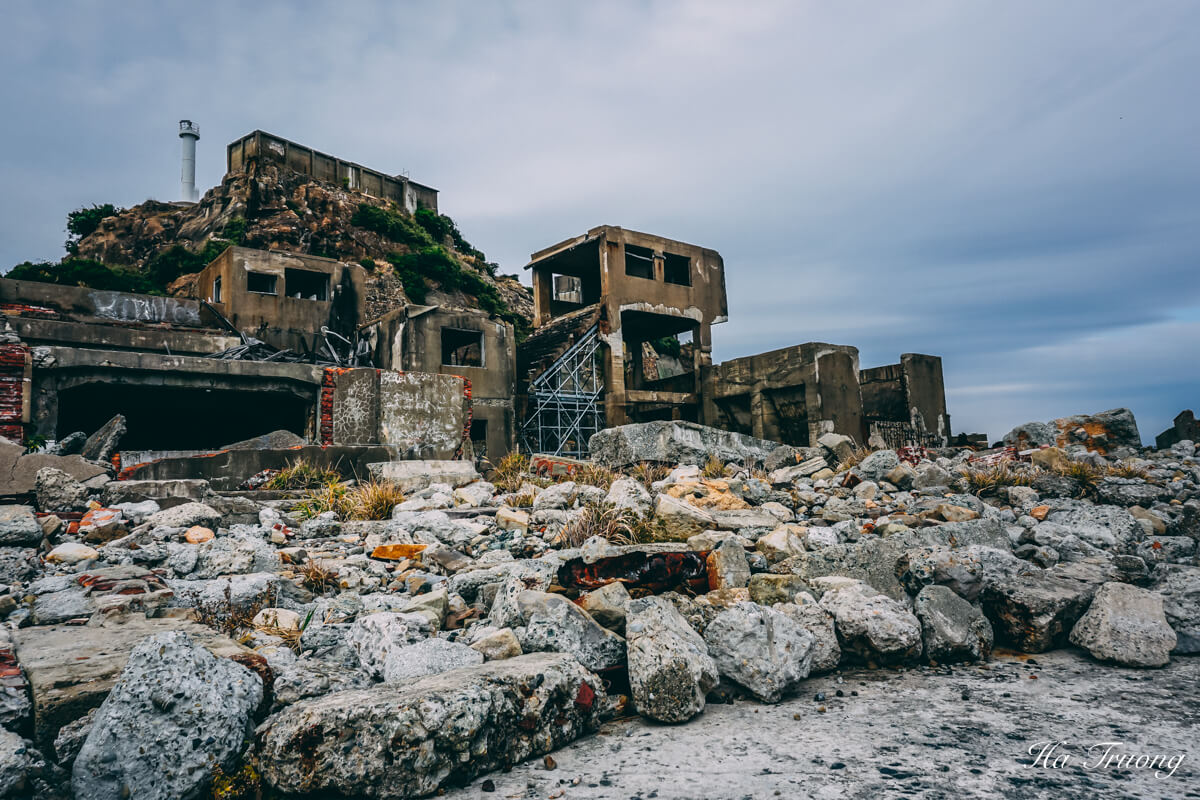
During its peak, Hashima island was home to 5300 people, five times more than Tokyo in the same period.
Electricity and Water
At first, the electricity was supplied by a generator, but later by the undersea cable from Takashima island from 1918.
There were vegetable gardens on the roofs of apartment buildings, and flowers and vegetables were grown there. It was believed that those were the first rooftop vegetable gardens in Japan.

Due to its location, Hashima island suffered from large waves, and it got even worse during hurricanes.
However, the Islanders also got used to them and developed the habit of watching high waves from the rooftops.
Why was Hashima island abandoned?
Due to the Energy Revolution, people started to use oil power instead, leading to the decline of coal demand. Therefore, the production of mine reduced along with the island’s population.
The coal mine on Hashima island was closed in January 1974 with the following abandon four months later in April.
The buildings on Gunkanjima island were preserved, becoming ruins that looked from afar. The island looked like a battleship – Gunkan – so the island was later named.
Visit this island, time seems to be stopping, and the surrounding landscape vividly recreates the old days.

Hashima Island nowadays
After the mine was closed, Gunkanjima was left abandoned for many years until 2009, when Gunkanjima got considered an industrial heritage site in Kyushu island.
You can now visit Gunkanjima island by taking tours from Nagasaki port.

Is the Gunkanjima battleship island safe to visit?
Yes, it’s safe to visit part of Gunkanjima island. However, when visiting Gunkanjima, you should follow safety protocols.
How much does it cost to go to Gunkanjima?
The cost of the Gunkanjima trip includes the boat tour service and battleship island entrance fee.
Boat tour fee:
- Weekday: 4,000 Yen
- Weekend, National Holiday, and Vacations: 4,500 Yen
Inclusive Of:
- Cruise experience
- English audio guide (optional)
- Insurance provided by the operator
Not Inclusive Of:
- Nagasaki City facility fee (adults: JPY300 and children: JPY150)
- Other personal expenses
- Tips and gratuities (optional)
Battleship island entrance fee:
Besides paying for the boat tour, each visitor has to pay an entrance fee to Hashima island: 300 Yen /adult and 150 Yen /child.

Book tour to Gunkanjima
Gunkanjima Concierge Company offers two trips daily:
- Morning tour: 9:40 am to 1:15 pm
- Afternoon tour: 12:50 pm to 4:20 pm
Here is the plan for the two cruises. You can depart either from Nagasaki pier or from Iojima island.
Morning Cruise
- 9:40 am meet up at Gunkanjima Concierge office
- 10:30 am depart from the pier
- 10:50 am arrive at Iojima
- 10:55 am depart from Iojima
- 11:15 am take a cruise around Battleship Island
- 11:30 am explore Battleship Island
- 12:20 pm leave from Battleship Island
- 12:40 pm arrive at Iojima
- 12:45 pm depart from Iojima
- 1:15 pm back to the pier
Afternoon Cruise
- 12:50 pm meet up at Gunkanjima Concierge office
- 1:40 pm leave from the dock
- 2:00 pm arrive at Iojima
- 2:05 pm depart from Iojima
- 2:25 pm cruise around Battleship Island
- 2:35 pm explore Battleship Island
- 3:25 pm departure from Battleship Island
- 3:45 pm arrive at Iojima
- 3:50 pm leave from Iojima
- 4:20 pm back to the pier
How to book tours to Gunkanjima?
You can book the Gunkanjima tour easily with Klook , a reliable and efficient online travel company. I’ve used Klook for several activities, so I recommend it.
The booking procedure is effortless.
By choosing the date and course, then paying by credit card, you will receive the confirmation through email and get ready for your trip.
Please note that you will receive confirmation of your booking’s availability through your email within two business days.
As we wanted to visit the Nagasaki museum in the morning, we opted for the afternoon tour.
After having lunch at Chinatown, we walked to the port at the meeting time stated in the email.
I was surprised at a line of people waiting for the tour in front of the lounge. We had to fill in some papers about safety protocol and paid extra for the entrance ticket to the island.

We got in the boat around 1:25 pm, and it departed shortly after that.

The ship went through the Venus Wing Bridge, and we could see Takashima Island from a far distance.
Finally, Battleship Island appears.
We got to cruise around the island and see it from different angles. It was terrific and overwhelming to see the ruins in person.
Landing time
We finally reached the Dolphin pier in Gunkanjima around 2:50 pm.
Our guide explained lots of details about the buildings and life on the island during the field trip. It was interesting to know that he lived on this island as a kid.
Before the tour, I imagined we could enter the island deeper, but we just got to see a small part of the island for safety reasons.

On Observation area 1, we got to see the coal storage conveyor belt. The coal was transferred to the storage facility via this conveyor belt, and the braces of the belt still survive today.

Back to Nagasaki
After 40 minutes, we returned to our ship to get back to Nagasaki.
On our way back, we got a chance to see a documentary about the island. It was interesting to see how life was on the battleship island compared to the field trip that I just had.

And here is Nagasaki harbor.

My thoughts on the tour
I felt like we spent most of the time on the cruise itself, not the island. It would be better if visitors were allowed to enter the buildings; however, I understood that it might be dangerous.
The field trip was quite rushed, especially if you wanted to take lots of pictures and listen to the stories at the same time.
However, it was a fantastic experience that I’ve ever had. Seeing how nature affected man-built architecture through time was priceless.

I would recommend staying in Nagasaki during your trip because there are many things to do in this prefecture .
You can read reviews and check the availability of accommodation in Nagasaki with Booking.com .
- How to travel to Japan on a budget
- Basic Japanese phrases and words you should know
- Best things to do in Fukuoka, Japan not to miss
- Tasty Japanese dishes to try on your trip
Note : We paid for our trip to Gunkanjima island, and the review above is based on our experience. As we have full rights to these images, it’s strictly prohibited to use them in any circumstance.
Ha is an avid traveler and writer with a background in marketing & hospitality. She's lived in a few countries and traveled to more than 30. When she's not traveling or writing, Ha loves trying new recipes.
Similar Posts
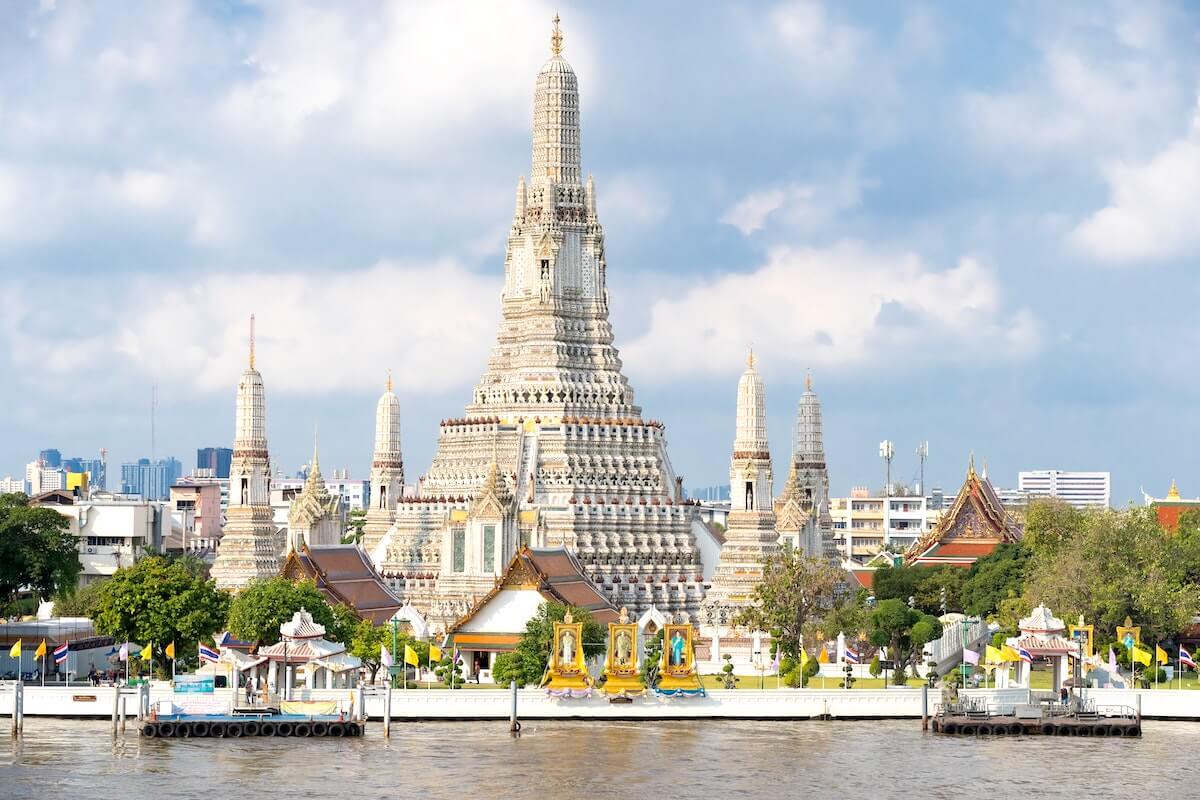
10 Best Things To Do In Bangkok Thailand
Bangkok is an amazing travel destination thanks to its stunning temples, distinct culture, and delectable food. What to do in…
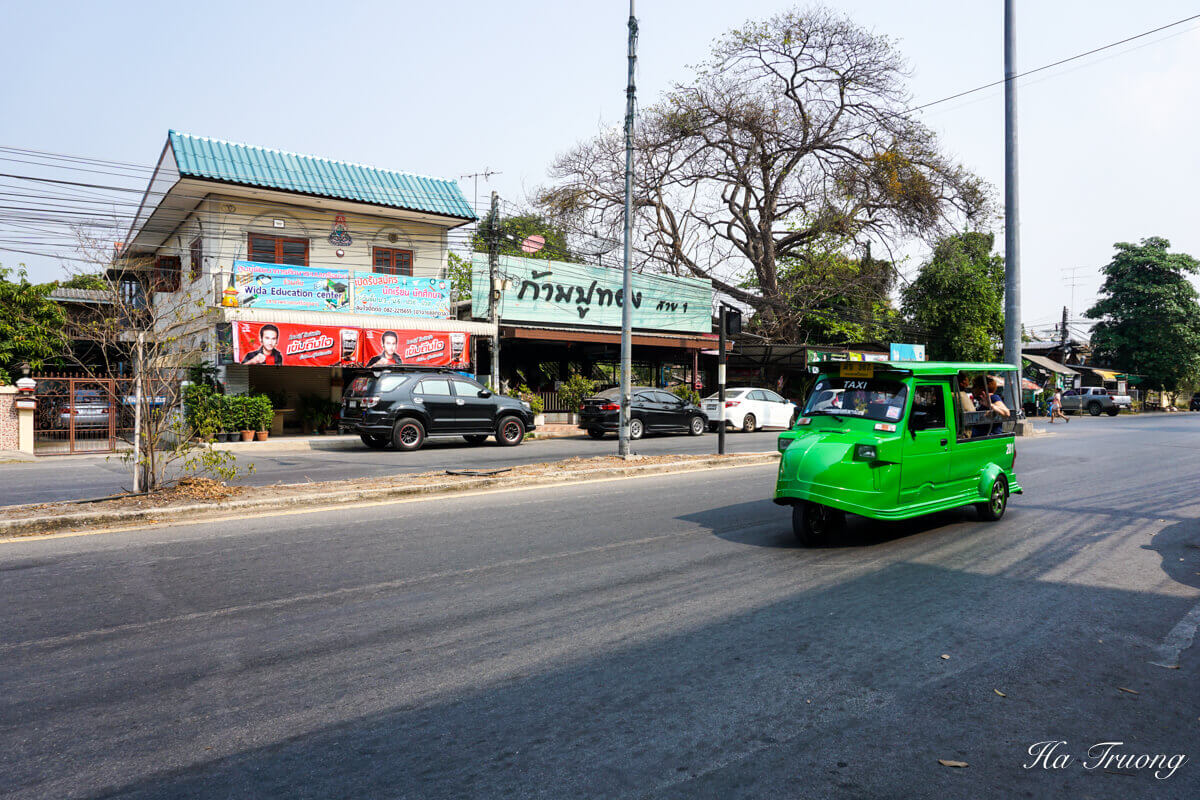
When is the best time to visit Thailand?
When is the best time to visit Thailand? This article is a detailed guide on the weather, festivals, and ideal…
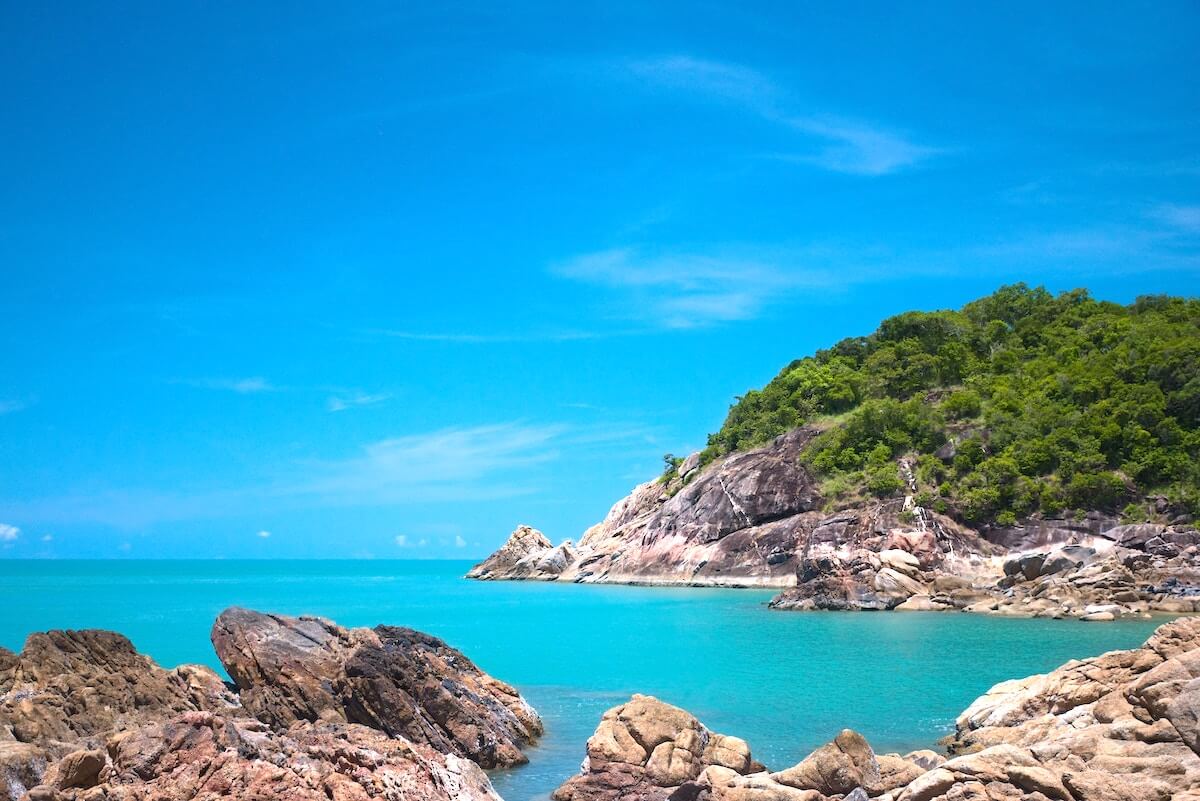
Easy Ways to Get from Krabi to Koh Samui Thailand
Are you enjoying Krabi‘s lush landscapes and now planning to visit Koh Samui’s idyllic beaches? In this guide, I’ll share…
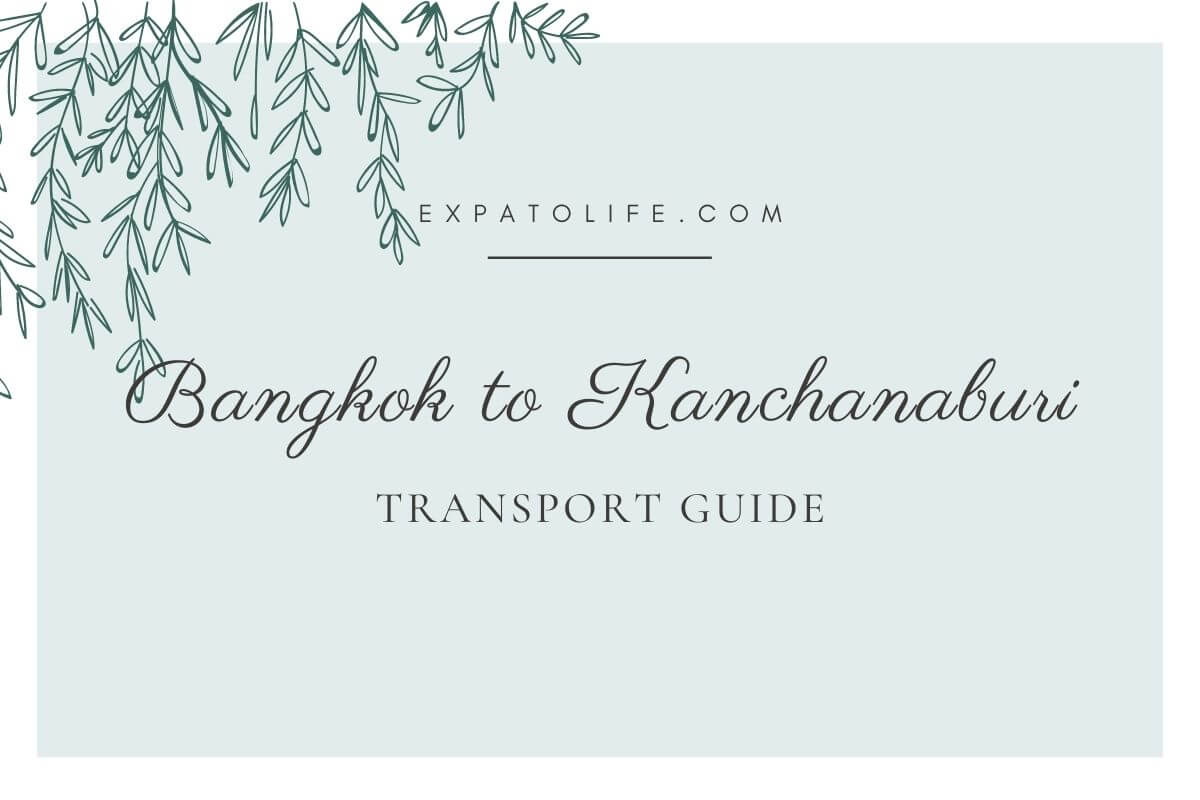
Bangkok to Kanchanaburi Thailand: Transport Guide
Kanchanaburi is famous for its historical sites, such as the Hellfire Pass bridge over the River Kwai. Kanchanaburi is 150…

A Detailed Guide To Hiking Mount Hallasan, Jeju Korea
Are you planning to hike Mount Hallasan on your trip to Jeju Island, South Korea? Mount Hallasan is the highest…
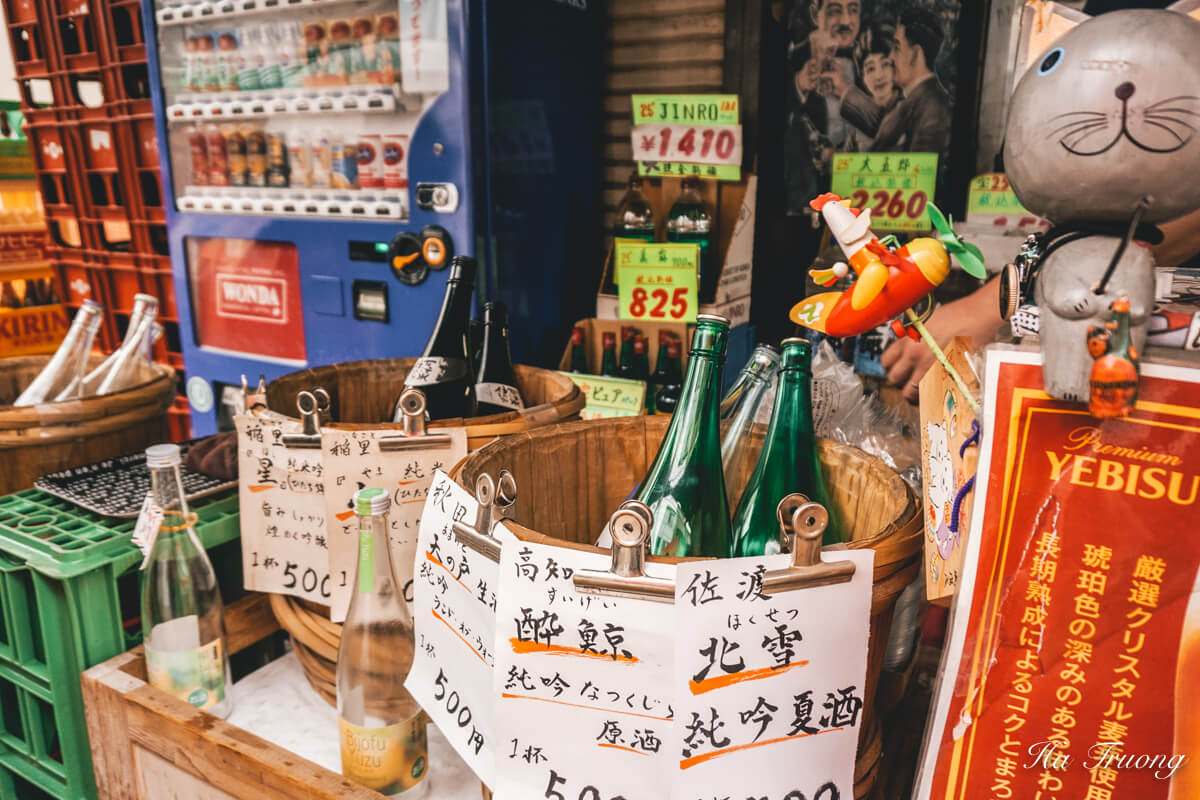
Tokyo Food Tour: Discover Old Town Tokyo In A Tasty Way
What is the best way to explore Tokyo? The answer may vary depending on each person, but for me, it’s…
Leave a Reply Cancel reply
Your email address will not be published. Required fields are marked *

- Visit Our Blog about Russia to know more about Russian sights, history
- Check out our Russian cities and regions guides
- Follow us on Twitter and Facebook to better understand Russia
- Info about getting Russian visa , the main airports , how to rent an apartment
- Our Expert answers your questions about Russia, some tips about sending flowers

Russian regions
- Bashkortostan republic
- Chuvashia republic
- Kirov oblast
- Mari El republic
- Mordovia republic
- Nizhegorodskaya oblast
- Orenburg oblast
- Penza oblast
- Samara oblast
- Saratov oblast
- Tatarstan republic
- Udmurt republic
- Ulyanovsk oblast
- Map of Russia
- All cities and regions
- Blog about Russia
- News from Russia
- How to get a visa
- Flights to Russia
- Russian hotels
- Renting apartments
- Russian currency
- FIFA World Cup 2018
- Submit an article
- Flowers to Russia
- Ask our Expert
Ulyanovsk city, Russia
The capital city of Ulyanovsk oblast .
Ulyanovsk - Overview
Ulyanovsk is a city in Russia located about 870 km southeast of Moscow, the administrative center of Ulyanovsk Oblast. It is named in memory of Vladimir Ulyanov (Lenin), a native of this city.
The population of Ulyanovsk is about 622,900 (2022), the area - 316 sq. km.
The phone code - +7 8422, the postal codes - 432000-432073.
Ulyanovsk city flag
Ulyanovsk city coat of arms.
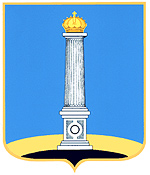
Ulyanovsk city map, Russia
Ulyanovsk city latest news and posts from our blog:.
26 June, 2014 / Abandoned church in the middle of nowhere .
3 February, 2011 / Tough minibus of Ulyanovsk city .
14 November, 2009 / Ulianovsk city ammunition depot explosion .
History of Ulyanovsk
Ulyanovsk in the 17th-19th centuries.
In 1648, by decree of Tsar Alexei Mikhailovich, the fortress of Sinbirsk was founded on the right bank of the Volga River in order to protect the eastern borders of the Tsardom of Russia from the raids of nomadic tribes (Nogai Tatars), as well as to colonize the Volga region.
In the fall of 1670, Sinbirsk was unsuccessfully besieged by the army of Stepan Razin - the Don Cossack, who was the leader of the 1670-1671 uprising, the largest in the history of pre-Petrine Russia. In 1678, 1,579 people lived in Sinbirsk.
In 1729, the coat of arms of Sinbirsk was approved - a white pillar topped with a golden crown in the azure field. In 1780, Sinbirsk was renamed Simbirsk. In 1793, 13,317 people lived in this town.
In 1812, Ivan Goncharov, a famous Russian novelist and critic, was born in Simbirsk. In 1836, Emperor Nicholas I visited Simbirsk and made a lot of orders for the construction of new buildings in the town, especially in its central part. In 1840, the Simbirsk Theological Seminary was opened.
More Historical Facts…
In 1845, a monument to Nikolay Karamzin (1766-1826) was opened - the author of one of the first generalizing works on the history of Russia and a reformer of the Russian literary language, who was born near Simbirsk. Today, this monument erected in Karamzin Public Garden is one of the symbols of Ulyanovsk. In 1848, one of the first libraries in the Volga region was opened in this town - the Karamzin Public Library.
In the summer of 1864, a terrible fire occurred in Simbirsk, which lasted 9 days. Only one fourth of the town buildings survived. In 1867, the merchant Yurgens opened the first bookstore in Simbirsk. In 1870, the future “leader of the world revolution” Vladimir Ulyanov (Lenin) was born in Simbirsk. Alexander Kerensky, a prominent Russian politician and statesman, was born here in 1881. According to the 1897 census, 43.3 thousand people lived in Simbirsk.
Ulyanovsk in the first half of the 20th century
From 1908 to 1912, Igor Kurchatov, the future creator of the Soviet atomic bomb, lived in Simbirsk with his parents and studied at the local gymnasium. In 1916, the construction of the Imperial Bridge over the Volga River was completed in Simbirsk. With a length of 2,089 meters, it was the longest bridge in the Russian Empire at that time.
After the First World War and the Russian Civil War, the city’s industry was in ruin. During the war years, not a single building was constructed in Simbirsk, street lighting disappeared, boulevards and parks fell into disrepair, up to a hundred residential buildings were destroyed.
On May 9, 1924, in connection with the death of Vladimir Ilyich Ulyanov (Lenin), Simbirsk was renamed into Ulyanovsk, and Simbirsk Governorate - into Ulyanovsk Governorate. Other proposed options for the new name of the city were such as “Lenin”, “Leninsk”, “Ilyich”.
By the end of the 1930s, almost all churches in Ulyanovsk were destroyed or used for other purposes. On the eve of the Second World War, Ulyanovsk was a provincial city with a population of about 110 thousand people. There were no large industrial enterprises, with the exception of the 3rd State Plant named after Volodarsky (Ulyanovsk Cartridge Plant) - one of the oldest defense enterprises in Russia, specializing in the production of cartridges for rifled weapons.
During the Second World War, Ulyanovsk became the place of evacuation of 17 industrial enterprises from the occupied regions and the front line. The Minsk Tank School, renamed the 2nd Ulyanovsk Tank School, was relocated from Minsk, the Mogilev Military Infantry School, which became the Ulyanovsk Military Infantry School, was relocated from Mogilev. In 1942, a medical institute evacuated from Voronezh began to work in Ulyanovsk.
From October 1941 to August 1943, the Moscow Patriarchate was in evacuation in Ulyanovsk, headed by Metropolitan Sergius. From 1942 to 1945, Andrei Sakharov, the future creator of the hydrogen bomb, academician and human rights activist worked at the Ulyanovsk Machine-Building Plant.
On January 19, 1943, Ulyanovsk became the center of the newly formed Ulyanovsk Oblast. From the second half of 1941 to the beginning of 1942, the population of Ulyanovsk, due to the evacuees, doubled and amounted to more than 200 thousand people. By 1945, as a result of re-evacuation, it decreased by 50 thousand and amounted to 152 thousand people.
Ulyanovsk after the Second World War
In the post-war period, Ulyanovsk became an industrial city. In 1953, during the construction of the Volga cascade of hydroelectric power plants, part of Ulyanovsk was included in the flooding zone of the Kuibyshev reservoir. In 1957, the Ulyanovsk airport was built. Since the 1960s, thanks to the high rates of housing and industrial construction, Ulyanovsk began to grow rapidly both in area and in population. On May 5, 1967, the 300,000th resident of the city was born.
In the 1969-1970s, in honor of the celebration of the 100th anniversary of the birth of Vladimir Lenin, the historical center of Ulyanovsk was built up with modern buildings: the hotel “Sovetskaya”, the House of Artists, the Memorial Center of Vladimir Lenin, the hotel “Venets”, the new railway station Ulyanovsk-Tsentralny, the new river station, the central airport Ulyanovsk-Tsentralny, the central department store, the central bus station, the Palace of Pioneers, the park “Friendship of Peoples”, etc.
With the construction of the Memorial Center of Vladimir Lenin, Ulyanovsk became one of the main tourist centers of the USSR, after Moscow and Leningrad. The city was not closed to foreigners, which distinguished it from many other industrial regional centers, but foreign tourists were not allowed to deviate from the route. On June 1, 1973, the 400,000th resident of Ulyanovsk was born. On April 16, 1982, the population of Ulyanovsk exceeded 500 thousand people.
On June 5, 1983, in Ulyanovsk, the river cruise ship “Alexander Suvorov” crashed into the railway bridge across the Volga (the Imperial Bridge). By mistake of the crew, the ship tried to pass under the non-navigable span of the bridge. As a result, more than 170 people died. The large number of casualties is explained by the fact that at the time of the collision, most of the passengers were in the movie theater and on the dance floor on the upper deck, which was completely destroyed by the collision with the bridge girder.
On July 17, 1987, the 600,000th resident of Ulyanovsk was born. The city’s tourist significance declined sharply after the collapse of the USSR. In 1998, Ulyanovsk celebrated its 350th anniversary.
In the 2000s, there was a discussion about the reverse renaming of the city to Simbirsk, but the residents of Ulyanovsk for the most part did not support this proposal. In 2009, the arches of the old railway bridge were replaced. On November 24, 2009, the Presidential Bridge across the Volga was opened, the second longest in Russia, with a length of about 6 kilometers.
Streets of Ulyanovsk
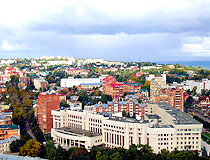
General view of Ulyanovsk
Author: Vladimir Kropotin
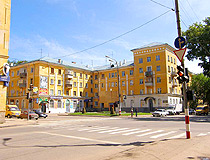
Soviet architecture in Ulyanovsk
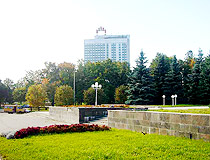
Hotel Venets in Ulyanovsk
Ulyanovsk - Features
From 1648 to 1780, the name of Ulyanovsk was Sinbirsk, and from 1780 to 1924 - Simbirsk. This name was given to the town by its founder, Bogdan Khitrovo, after the name of the settlement of Sinbir (named after the Bulgarian prince Sinbir), the remains of which were located nearby. In 1924, after the death of Vladimir Ulyanov (Lenin), Simbirsk was renamed into Ulyanovsk.
Ulyanovsk is located in a forest-steppe zone on the Volga Upland, on both banks of the Volga River (Kuybyshev Reservoir). The climate is moderately continental. The average temperature in February is minus 10.4 degrees Celsius, in July - plus 20.2 degrees Celsius. A characteristic feature of Ulyanovsk is the constant winds blowing from the Volga.
This city is a major transport point, lying between central Russia and the Urals. Neighboring regional centers are three to five hours away by car. There are two international airports near the city - Ulyanovsk-Central (ULV) and Ulyanovsk-Vostochny (ULY).
The banks of the Volga in Ulyanovsk are connected by two bridges. The old railway bridge was officially opened in 1916 and was named “Imperial of His Majesty Nicholas II”. In 1917, it was renamed Freedom Bridge. In 2009, it again began to be called “Imperial Bridge”. The new bridge (also called “Presidential Bridge”) was commissioned on November 26, 2009.
Public transport is represented by trams, trolleybuses, buses, and minibuses. In Ulyanovsk tram lines are located exclusively in the right-bank part of the city and trolleybus lines are in the left-bank part. In the last years of the USSR, it was planned to build a subway in Ulyanovsk.
It is a multi-ethnic city. The ethnic composition according to the 2010 All-Russian Population Census: Russians (77.65%), Tatars (12.64%), Chuvash (5.02%), Mordovians (1.4%). The economy of the city is based on the enterprises of the automotive industry, engine building, aircraft building, instrument making, machine building, and metalworking.
Ulyanovsk has a high potential for the development of the tourism industry. The tourist image of Ulyanovsk as “The Birthplace of Vladimir Lenin” is supplemented with some new ones now: “Russian provincial town of the 19th century”, “Homeland of Oblomov”, “Architectural Museum in the Open Air”.
The City Day of Ulyanovsk is traditionally celebrated on the second Sunday in September.
Main Attractions of Ulyanovsk
Lenin Memorial - a whole museum complex dedicated to Vladimir Ulyanov (Lenin) and his family. This is one of the largest historical and museum complexes in the Volga region. The main building was constructed for the 100th anniversary of Lenin’s birth in 1970.
This is the only museum in the world that reflects the entire life of Lenin. It has more than 70 thousand exhibits including authentic belongings of the Ulyanov family, documents, photographs, and other items related to different periods of Russian history. Lenin Square, 1.
House-Museum of Vladimir Lenin . The exhibition of this museum is located on the territory of a wooden estate - a monument of urban architecture that belonged to the Ulyanov family at the end of the 19th century. Lenin spent his childhood and youth here. Lenina Street, 68.
Novy Venets Boulevard - a pedestrian street in the center of Ulyanovsk located on the highest point of the city. From here you can see the Volga, Imperial Bridge, and city districts. The boulevard was finally built up in the 1960s. The construction of many buildings was related to the celebration of the 100th anniversary of Lenin’s birth.
Museum of Local Lore named after Ivan Goncharov . This museum occupies a beautiful mansion with an elegant tower built as a monument to the great Russian writer Ivan Goncharov. The exhibition halls display archaeological artifacts and fossils. A significant part of the exposition is devoted to the life and work of Ivan Goncharov. An interesting numismatic collection and an exhibition of folk costumes also attract the attention of visitors. Novy Venets Boulevard, 3/4.
Historical and Memorial Museum of Ivan Goncharov - a magnificent building, which is a historical and architectural sight of Ulyanovsk. In 1812, the famous Russian writer Ivan Goncharov was born in one of its rooms. The exposition occupies all three floors of the building. A separate hall is dedicated to the history of the building itself, in the remaining halls there are thematic exhibitions related to the personality of the writer and his family. There are also halls that house historical collections and a collection of merchant household items. The tower of the building houses the Museum of the History of the Simbirsk Town Clocks. Goncharova Street, 20.
Museum “Simbirsk Classical Gymnasium” . Simbirsk was one of the first Russian cities to introduce secondary education for children. The museum exposition is dedicated to the history of the development of education in the Russian Empire. It is located in a former gymnasium, where Vladimir Ulyanov and Alexander Kerensky studied at one time. Inside, the atmosphere of the 19th century has been recreated. The interiors of classrooms, halls, dressing rooms, and a gym have been restored. The building that houses the museum was constructed in 1790. Spasskaya Street, 18.
Museum “Fire Department of Simbirsk-Ulyanovsk” . The exposition of this museum is located in the 19th century building previously occupied by the town fire brigade. The museum was opened after the restoration of the building in 1979. The collection consists of pre-revolutionary and Soviet sections. In the central part there is a diorama depicting the fire of 1894 in Simbirsk. Lenin Street, 43.
Historical and architectural complex “Simbirsk Fortified Line” . At the time of the foundation of Ulyanovsk, the Simbirsk line protected the Russian land from the raids of nomads from the east. Today, you can find a unique historical and architectural museum here. It features a defensive fortress and an earthen rampart, which were restored based on historical documents and remains found by archaeologists in Simbirsk. The exposition includes examples of Russian weapons, old documents, maps, diagrams, decrees, and a model of a water mill. Leo Tolstoy Street, 43a.
Museum of the History of Civil Aviation . This museum located near the airport Ulyanovsk-Tsentralny has an airfield and 4 halls with exhibits illustrating the history of aviation from the time of the Russian Civil War to the present day. In terms of the total number of exhibits (about 9 thousand), it is the country’s largest aviation museum. One of the unique exhibits is the Tu-144 supersonic airliner. Aviatsionnaya Street, 20a.
Balalaika Museum - a unique museum with a collection of the rarest balalaikas (a musical instrument very popular in pre-revolutionary and Soviet Russia). The guests of the museum are invited to immerse themselves in the world of village music, to hear the sound of real peasant balalaikas. Here you can also taste tea made from herbs collected in the forests of the Ulyanovsk region. Bebelya Street, 19.
Savior Ascension Cathedral - a picturesque Orthodox church of sky-blue color built in the Baroque style in the 2000s to replace the demolished Ascension Cathedral (albeit in a different place). Ulyanovskaya Street, 2.
Holy Resurrection-Germanovsky Cathedral - one of the oldest churches in Ulyanovsk built in the early 18th century. During the years of Soviet power, it was closed and used as the state archive. In 2003, the building was returned to the Orthodox diocese. Gogolya Lane, 11.
House of Merchant Bokounin - a beautiful monument of wooden architecture, one of the architectural gems of Ulyanovsk. It was erected at the beginning of the 20th century on the territory of the estate of the Ulyanovsk merchant Sergei Bokounin. Part of the premises is occupied by the restaurant “Teremok”. Radishcheva Street, 4.
The Volga River (Kuibyshev Reservoir) - the largest artificial reservoir on the Volga created in the 1950s. The reservoir is 500 km long, with a maximum width of 44 km. Its powerful water resources are used to generate electricity. Due to its gigantic size, it significantly affected the Volga itself, changed the flow regime and began the processes of coastal washout. Home to many species of fish, the reservoir attracts fishing enthusiasts to its shores.
Ulyanovsk city of Russia photos
Ulyanovsk views.
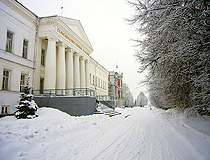
Ulyanovsk Agricultural Academy
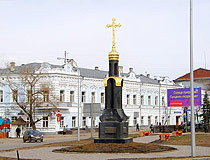
Architecture of old Simbirsk
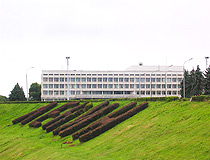
Lenin is everywhere in Ulyanovsk
Sights of Ulyanovsk
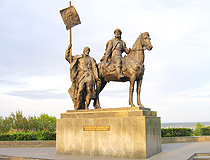
Monument to Bogdan Khitrovo - the founder of Simbirsk (Ulyanovsk)
Author: Vladimir Baboshin
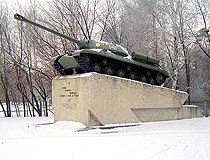
Tank IS-3 in Ulyanovsk
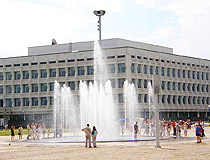
Light and music fountain Tornado in Ulyanovsk
Pictures of Ulyanovsk
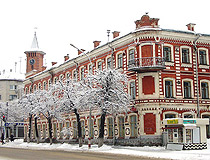
Museum of Ivan Goncharov in Ulyanovsk
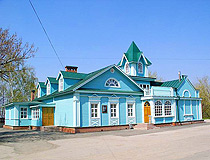
Simbirsk Photography Museum in Ulyanovsk
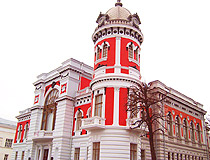
Ulyanovsk Museum of Local Lore
Author: Andrey Mishchenko
- Currently 3.01/5
Rating: 3.0 /5 (207 votes cast)
Sponsored Links:
Browse Econ Literature
- Working papers
- Software components
- Book chapters
- JEL classification
More features
- Subscribe to new research
RePEc Biblio
Author registration.
- Economics Virtual Seminar Calendar NEW!

The Politics of In/Visibility: Carving Out Queer Space in Ul'yanovsk
- Author & abstract
- Related works & more
Corrections
- Francesca Stella
Suggested Citation
Download full text from publisher.
Follow serials, authors, keywords & more
Public profiles for Economics researchers
Various research rankings in Economics
RePEc Genealogy
Who was a student of whom, using RePEc
Curated articles & papers on economics topics
Upload your paper to be listed on RePEc and IDEAS
New papers by email
Subscribe to new additions to RePEc
EconAcademics
Blog aggregator for economics research
Cases of plagiarism in Economics
About RePEc
Initiative for open bibliographies in Economics
News about RePEc
Questions about IDEAS and RePEc
RePEc volunteers
Participating archives
Publishers indexing in RePEc
Privacy statement
Found an error or omission?
Opportunities to help RePEc
Get papers listed
Have your research listed on RePEc
Open a RePEc archive
Have your institution's/publisher's output listed on RePEc
Get RePEc data
Use data assembled by RePEc

videoPlayer

IMAGES
VIDEO
COMMENTS
For past landing information. The Gunkanjima Landing & Cruise is reservation ONLY. Policies and Inhibition Standards Regarding Landing. Yamasa Shipping always makes sailing and landing safely its top priority. Due to both national and city law and safety regulations, approaching and landing at Gunkanjima's pier is strictly prohibited.
Gunkanjima Boat Tour by the Black Diamond. ... Usually: Usually: Boarding Fee. Adults ¥3,600 Children ¥1,800 *Is required "Landing fee" separately. Adults ¥310 / Children ¥150. Landing Course. 3 hours full tour of! W landing of Takashima and warship Island ! Tour at the Black Diamond of stylish design!Would you like to experience the ...
Courses. Important points. Cancel charge. In April, 2009 the ban on landing on Hashima (commonly called Gunkanjima) was lifted. The trip will give you a firsthand experience of this once prosperous deserted island. Why not feel the unique history of Nagasaki through a Gunkanjima tour, visiting the site of Kitakeii Mine, Glover Garden and other ...
The Gunkanjima Landing & Tour Cruise: Successful Shipping / Landing Rates. (unit:%) 2023/06
Joined heritage cruise and landing tour operated by Gunkanjima Joriku cruise. Got on board on Black diamond, you see heritage site with guiding but only Japanese. You also visit one island and see miniature to understand history of Gunkanjima before landing Hashima. You need to follow guideline and walk with guide but you take photo.
Gunkanjima (軍艦島) is a small island located about 20 kilometers from Nagasaki Port. Until 1974, the island served as a coal mine, and more than 5000 residents called the 480 meter long, 150 meter wide island home, resulting in the highest population density in history recorded worldwide. To accommodate so many people in such a small area ...
This has increased attention to Hashima (Gunkanjima). In April, 2009(the 21th year of Heisei), the ban on landing on the island was lifted, making tours on the island available.(*) *Only when safety standards are met. Boarding Fee Adults ¥3,600 Children ¥1,800 *Is required "Landing fee" separately. Adults ¥310 / Children ¥150
Joined heritage cruise and landing tour operated by Gunkanjima Joriku cruise. Got on board on Black diamond, you see heritage site with guiding but only Japanese. You also visit one island and see miniature to understand history of Gunkanjima before landing Hashima. You need to follow guideline and walk with guide but you take photo.
Gunkanjima Landing & Cruise (English/Japanese) Gunkanjima Tour (Japanese) Ebisu Cruise (Japanese) Prices don't differ all that much. For a "cruising and landing" tour the price is about ¥4,000 per person including the ¥300 landing fee levied by Nagasaki City. Guided tours take approximately 3 hours, including a 1 hour tour of the island ...
Hashima, a decaying bubble. Hashima, often referred to as Gunkanjima, or Battleship Island, due to its boat-like profile, is a UNESCO World Heritage Site located 15km from Nagasaki 's city center. Coal mining kicked off here around 1887 and continued for nearly a century until 1974. At its peak, Hashima's population was over 5,000 people ...
Several companies offer such boat tours to Gunkanjima for about ¥4000-¥5000 per person, such as Gunkanjima Concierge, Gunkanjima Cruise and Yamasa Shipping. Prior booking is recommended. ... Once you've disembarked at the landing stage, the guides take you to three observation decks along the southern end of the island. During 45 minutes on ...
The tours have audio guides for foreigners as the tours are conducted in Japanese. They boast an impressive 94% landing rate and a 91% departure rate. Gunkanjima Concierge ticket classes. This cruise is a little different from the others in that there are different ticket classes.
We have established Gunkanjima as a tourist destination since 1997 and have led the tourist ferries in the surrounding oceans of Nagasaki Port. We provide safe and sound cruises to our customers through tours that are based on our many years of experience. [Tourist Attractions Nearby] Hashima Island
A very special ruins from coal mine. Dec 2015 • Couples. Gunkanjima is such a unique place where coal miners abandoned the island around 40 years ago after the fall of coal consumption. Yamasa cruise had offered a high-valued service. We joined the itinerary with landing sightseeing.
Take a cruise from Nagasaki Port to UNESCO World Heritage Site Gunkanjima (Battleship Island) that has been getting worldwide attention as it was the model for the "Dead City" in the James Bond movie "Skyfall" See beautiful views of Nagasaki on board, and upon landing, explore this abandoned relic from the Meiji Era.
Gunkanjima Landing & Cruise The island became open to the public for visiting on April 22, 2009. You will be enchanted by the breathtaking views of "Gunkanjima", known as the man-made-island for the seabed coalmine, after landing.
A mystic island indeed; you could call it 'Ghost Island', but to me it feels more like an art museum, also considering that "Battleship Island" (that's how it is also called) has been put on the tentative UNESCO World Heritage list as part of the Modern Industrial Heritage Sites in Kyushu and Yamaguchi. Before its reopening to visitors in 2009 landing on the island was ...
We got to cruise around the island and see it from different angles. It was terrific and overwhelming to see the ruins in person. Landing time. We finally reached the Dolphin pier in Gunkanjima around 2:50 pm. Our guide explained lots of details about the buildings and life on the island during the field trip.
It is named in memory of Vladimir Ulyanov (Lenin), a native of this city. The population of Ulyanovsk is about 622,900 (2022), the area - 316 sq. km. The phone code - +7 8422, the postal codes - 432000-432073. Local time in Ulyanovsk city is January 23, 6:04 am (+4 UTC).
Downloadable (with restrictions)! This essay contributes new insights to current debates about the construction and meaning of queer space by considering how city space is appropriated by an informal 'lesbian' network in Ul'yanovsk, Russia. The group routinely occupied very public locations, meeting and socialising on the street or in mainstream cafés in central Ul'yanovsk, although ...
Abstract. This essay contributes new insights to current debates about the construction and meaning of queer space by considering how city space is appropriated by an informal 'lesbian' network in Ul'yanovsk, Russia. The group routinely occupied very public locations, meeting and socialising on the street or in.
Weather and other conditions for using Hashima's (Gunkanjima's) pier for landing. Arrange one or more guides which perform a visitor's guidance etc. [The standard in the case of forbidding use of a pier] 1. When the wind velocity reaches above 5 meters. 2.
Mom charged after leaving kids to go on cruise. A 29-year-old mother in Texas has been charged after she left her two young children at home alone while she went on a cruise. April 22, 2024 12:45 ...
12 These included semi-structured, in-depth interviews with 61 non-heterosexual women; eight expert interviews with Moscow-based community activists and individuals working on commercial projects targeting a 'lesbian' audience; fieldwork notes of the community events and social gatherings I attended; and discourse analysis of media sources from the Russian mainstream and gay and lesbian media.